“We live in a wonderful world that is full of beauty, charm and adventure. There is no end to the adventures that we can have if only we seek them with our eyes open.” – Jawaharlal Nehru, first prime minister of India

Japan – Part 8
Tokyo ~ The Finale
From the spiritual and peaceful surroundings of Mt. Koya, we return to the high energy, organized chaos that is Tokyo via our final Shinkansen (travel time of 2h 41m – Japanese timetables are most precise). David held his breath awaiting the appearance of …
Mt. Fuji
Fortunately, our travel agent seated us on the left-hand side of our Shinkansen train car; perfectly arranged for sighting the iconic landmark, Mount Fuji, weather permitting.
As luck would have it, “Fuji-san” cooperated! I was snoozing along with the train’s soft, rhythmic whooshing sound; there’s no rocking – these trains are so darn smooth. Suddenly, David jabbed me, “Mt. Fuji!” And there she was in the not too far distance, looming large and majestically. I thought of Barbra Streisand’s famous line from “Funny Girl, ‘Hello, Gorgeous!’”
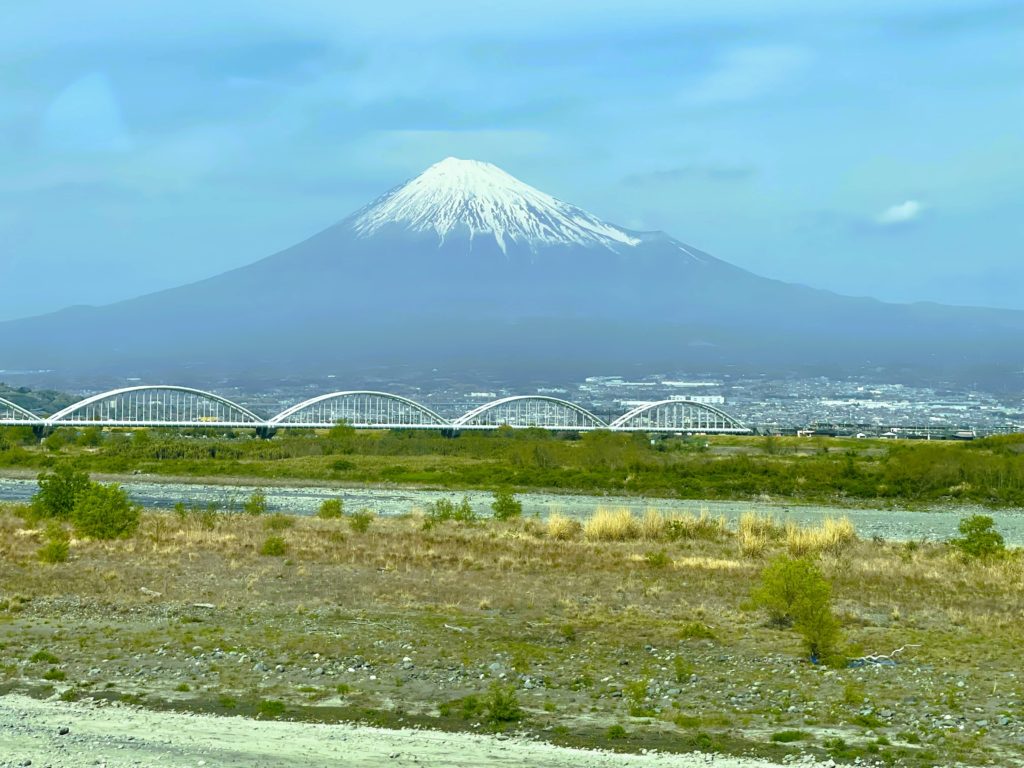
Zooming by at 200 kilometers per hour, we quickly snapped away with our cellphones; hoping for the best in capturing decent photos.
Mount Fuji was designated an UNESCO World Heritage Site in 2013. The mountain is recognized for its cultural, historical, spiritual, and religious significance, and is a popular symbol in Japanese art with its perfectly shaped conical top.
It’s an active volcano with an altitude of 12,389 feet, the highest peak in Japan. Fuji’s last eruption occurred in 1707 during the Edo period. However, it’s still classified as active. It’s popular for mountain climbing with several trails leading to the snowy summit.
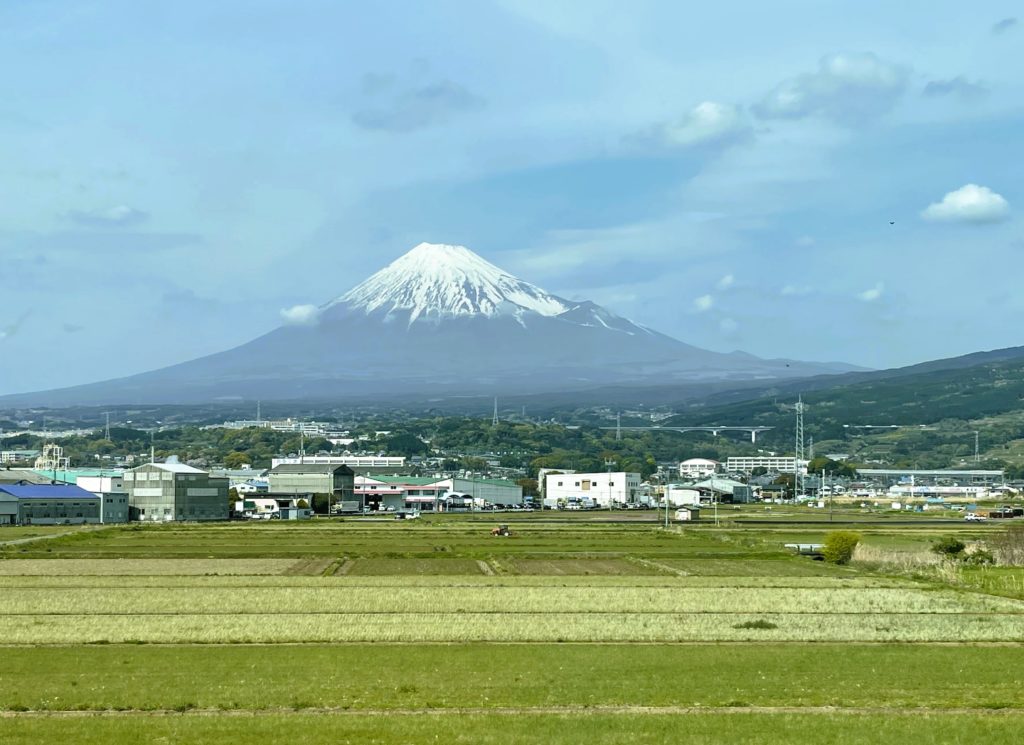
David’s vacation is now complete. Initially, he was saddened by the fact that we couldn’t see Mt. Fuji from Tokyo or Hakone at the start of our trip with all the rain. After having seen it featured on screen, in books and artworks, and now in person … his face said it all with joy and excitement. Mt. Fuji does that to people.
A smooth arrival in crazy, chaotic Tokyo Station, still abuzz and choked with humanity, but now we’re smarter, wiser and more learned in how to navigate and go with the flow of the crowds. Our final two days we’d be on our own without a local guide. After two weeks, we could proudly proclaim ourselves inveterate Japanese travelers; more confident Tokyoites.

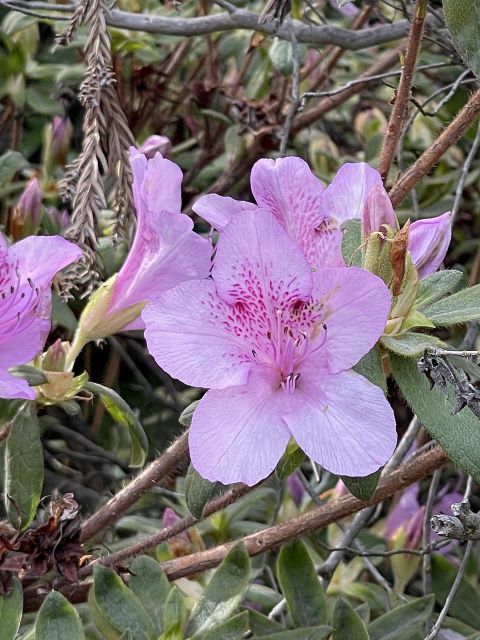
Throughout our travels in Japan, besides viewing all the Sakura ~ Cherry Blossoms exploding everywhere, one couldn’t help but notice all the smart, bright colored mini-cars about. They’re called a Kei Car and they’re darn cute!
Kei Car
From the start, I said to David, “I want one of those!” The Kei Car is the Japanese vehicle category for the smallest highway-legal passenger cars, with restricted dimensions and engine capacity. They’re small, lightweight vehicles designed to be practical, comfortable, and affordable for everyday city use and extremely fuel-efficient. Young or old, male or female, the Japanese have embraced the small car big time.
Specifications: Kei Cars are limited to a maximum length of 11 feet and a maximum width of 4.9 feet. They’re also limited to a maximum engine size of 660cc and a maximum power output of 63 horsepower and 60 kilometers or 37 miles per hours top speed. Speed racers they are not.




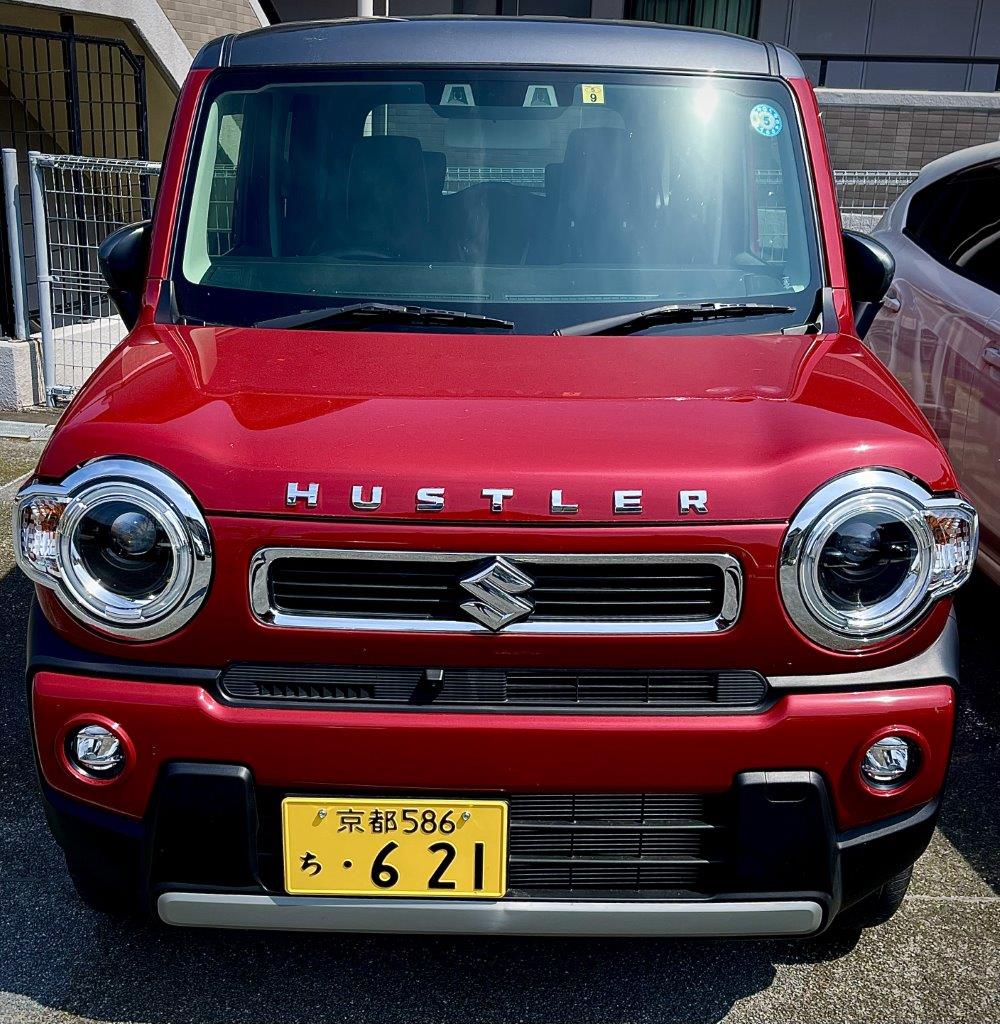
To me, their main attraction, besides the eye-catching boxy design, was the variety of colors, from soft pastel to rich jewel tones. They added to the vibrancy of the cities. Best of all, they’re totally customizable.
I fell head-over-heels in love with them and desperately wanted to bring one of these “Love Bugs” home with me in my check-in luggage, as they’re about the same size (Not! But I can dream).
Shinjuku
There were still a few districts left undiscovered in Tokyo, so our first night we headed for the bright lights of “Shinjuku.” We did the famous Shibuya Crossing – the world’s busiest pedestrian crossing, with as many as 3,000 people crossing at a time.
Known for its vibrant nightlife, shopping, and entertainment areas, including Kabukicho, which is Tokyo’s largest red-light district. Girls! Girls! Girls!
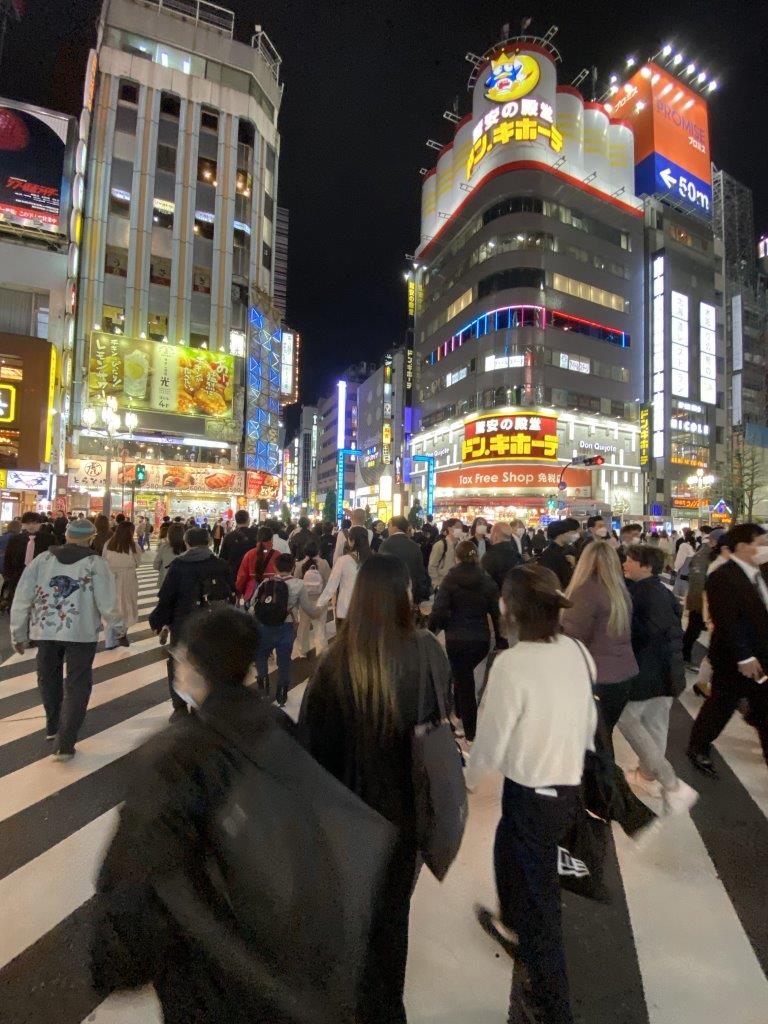

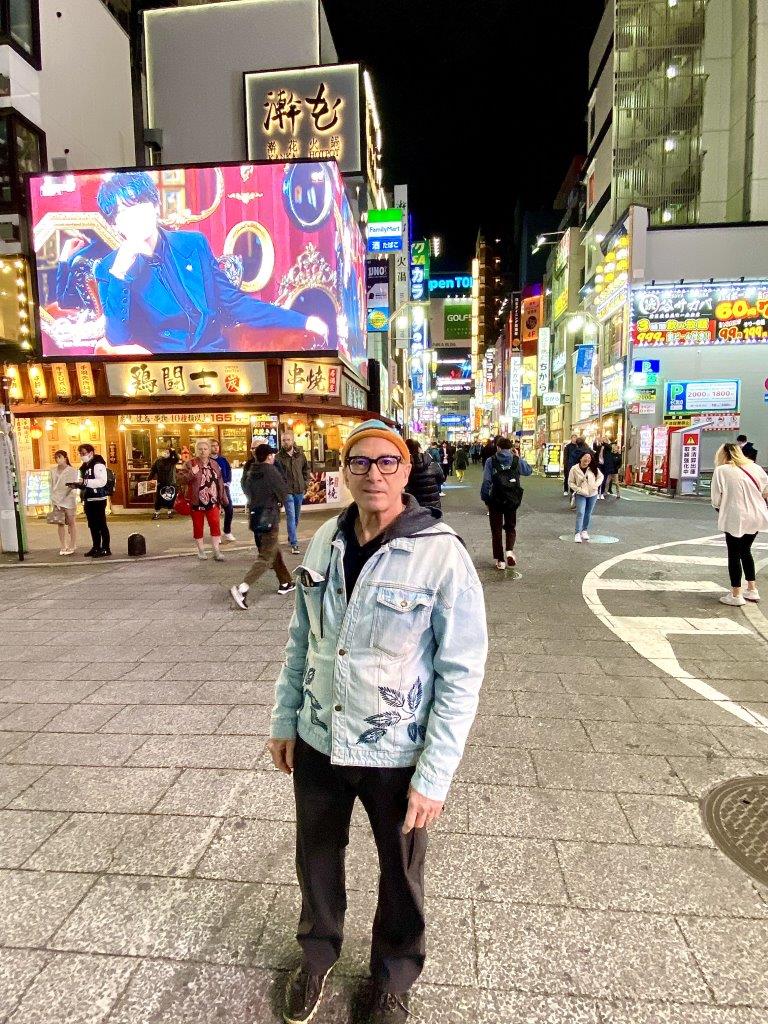

Walking about, I sensed that there was some sort of underlying seediness; though not speaking the language, I couldn’t quite put my finger on what was going on in the streets. But at least Godzilla was in the house to protect us from anything unsavory.
Famished, we began searching for a place to eat, but how do you choose from the dozens of places that crowd every small side street and alleyway? A brightly lit sushi countertop restaurant caught our attention. It was filled with locals, so we went in and the older Japanese woman in charge of things, showed us where to sit.

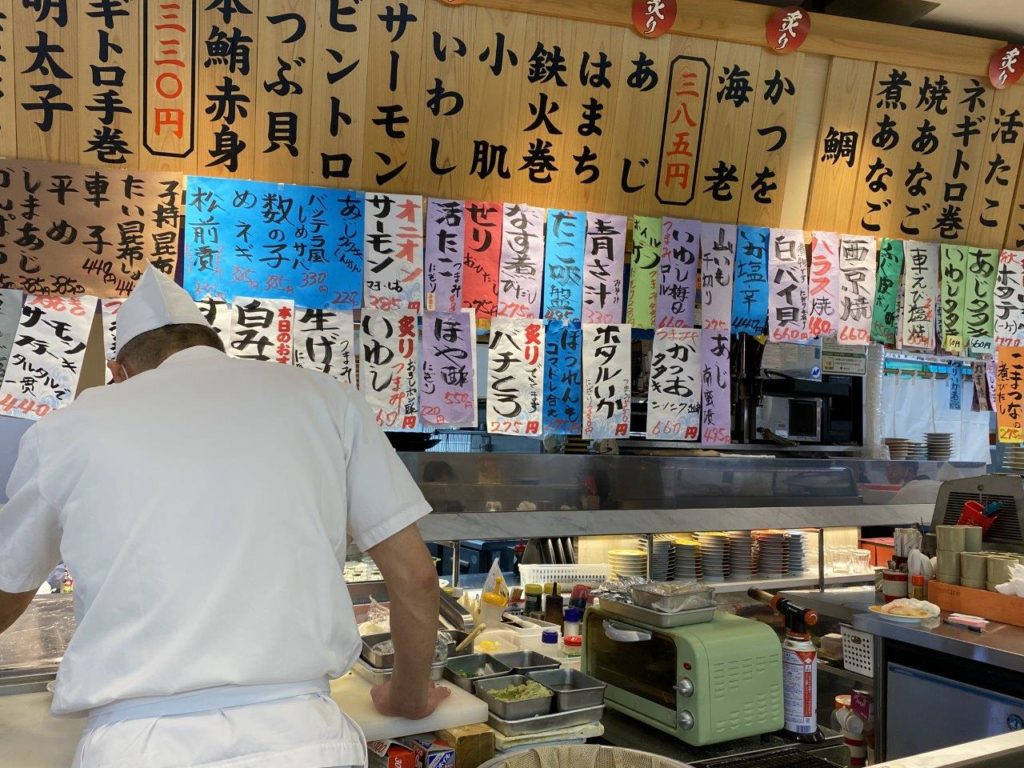
Though we were at a loss language wise, fortunately the menu had pictures, so the old pick and point system to order was utilized successfully, and in short order, we had a very satisfying sushi meal. Amazingly, portion size was double what we’re used to eating in the States.
In Los Angeles, we’d drive out east to suburban Alhambra to buy some Beard Papa’s, a U.S. outpost of the famous Tokyo cream puff chain. David and his uncanny sweet tooth sniffed-out a nearby shop in the Shinjuku train station, and off we went on a cream puff search. With the power of the sweets gods behind us, we found the yellow Beard Papa symbol awaiting us at the tiniest hole-in-the-wall counter. We left the station with a yellow box filled with their delicacies to enjoy back at the hotel with a cuppa. Japanese oishii! (delicious!). Beard Papa’s = Life is Sweet!
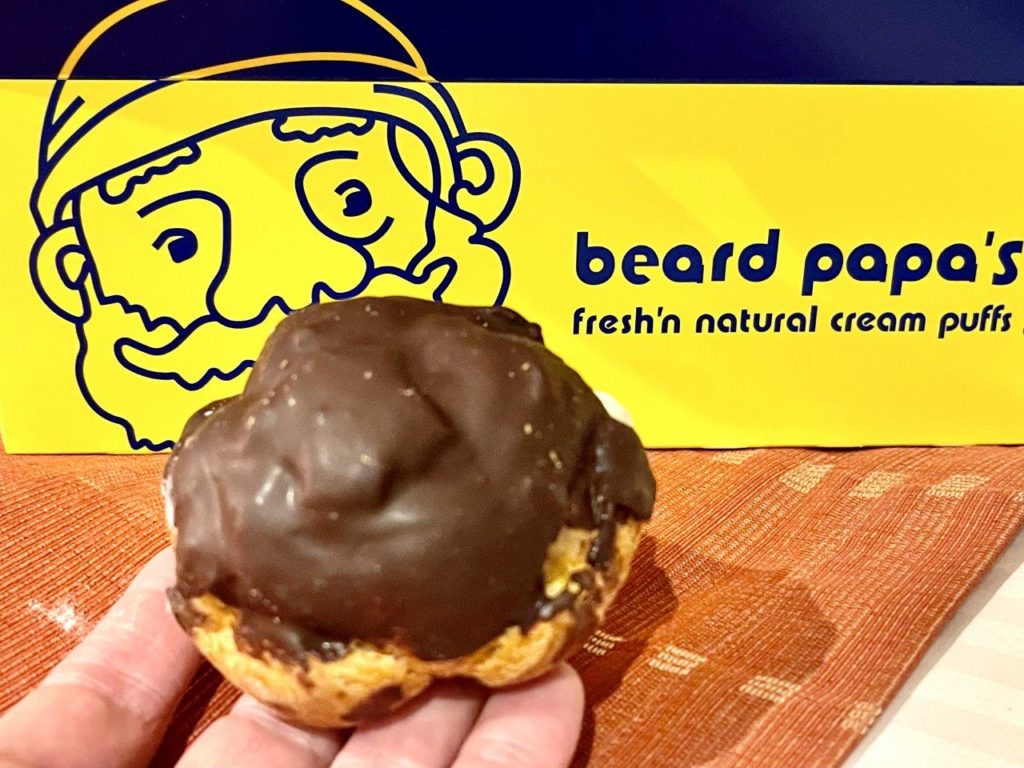

As I’ve written before, Tokyo’s Park Hotel was a walking art gallery. Now that we’ve returned, we chose a special room painted by a local artist; appropriately we selected the Carp Room. In Japanese folklore, the carp symbolizes strength, determination, perseverance, and success. It’s seen as a positive and auspicious creature, often inspiring people to overcome challenges and achieve their aspirations.
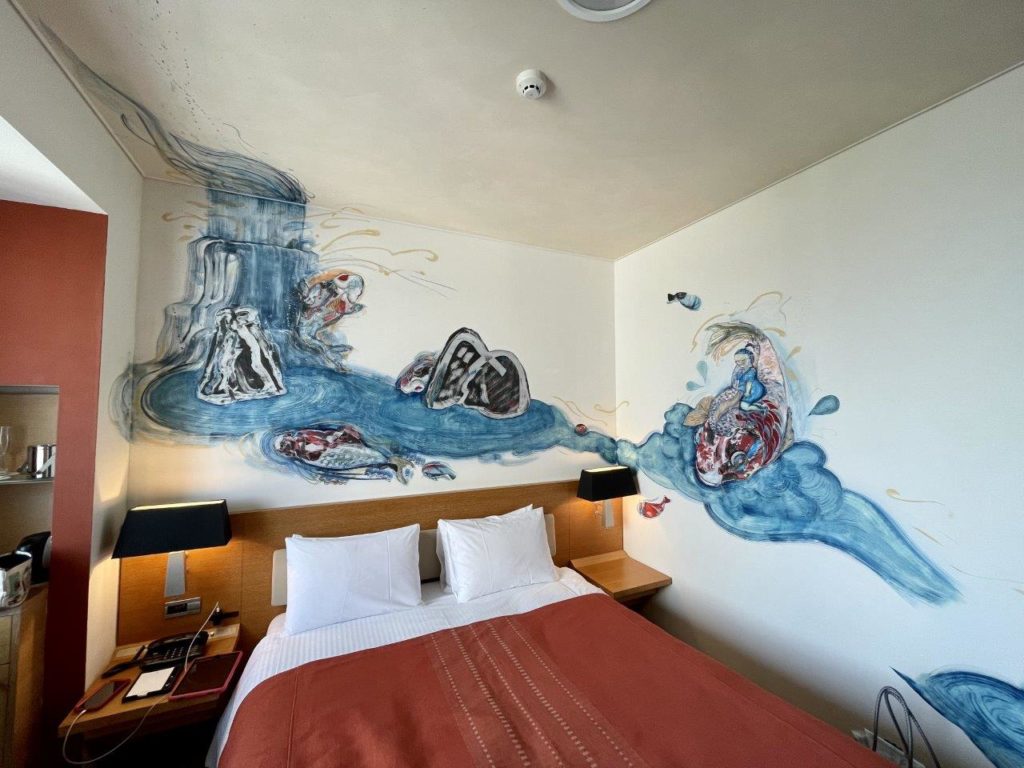
These final two days in Tokyo would be on our own. Since becoming great fans of Sumo wrestling, with their matches lasting only but a few seconds, it’s become my go-to sport to follow.
I’d scheduled a visit to a Sumo Stable to witness a morning practice with Viator, a tour company that we’ve used before, but at the last minute they changed the tour, so we cancelled it. Oh well, at least we’ve got our Kyoto Sumo fans and wrestling keychains as souvenir reminders.

Sadly, another canceled tour was the new Toyosu Fish Market, opened just five years ago. I got to visit the original Tsukiji Fish Market 20 years ago, when you had to arrive by 5am to experience the frenzy of the tuna auctions with sellers and buyers haggling for the best price.
It was quite a spectacle that I wanted David to observe. Since they moved from Tsukiji Market to the new market at Toyosu, the public is allowed access only by lottery that’s held every month. It’s now a quick 15-minute visit in a specified area; and you no longer can wander around the auction site. We entered the lottery, but to no avail.
No sumo wrestlers. No fish. But there’s always fashion!
CHRISTIAN DIOR
Ooh là là ~ Don’t despair, dear readers, the day will turn out to be an overwhelming sensory sensation for your eyes. Step up, step in and see “Christian Dior: Designer of Dreams,” a traveling retrospective that celebrates the famous fashion brand of the French couturier. The massive exhibition showcases the House of Dior’s history, from its founding in 1947 to the present day.
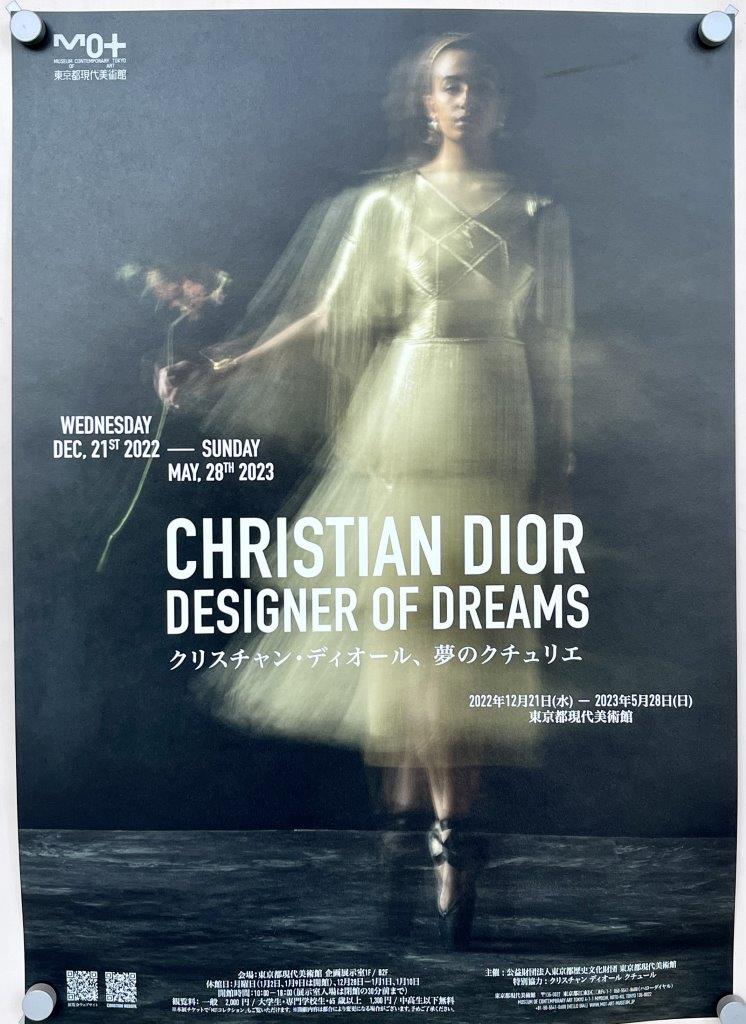
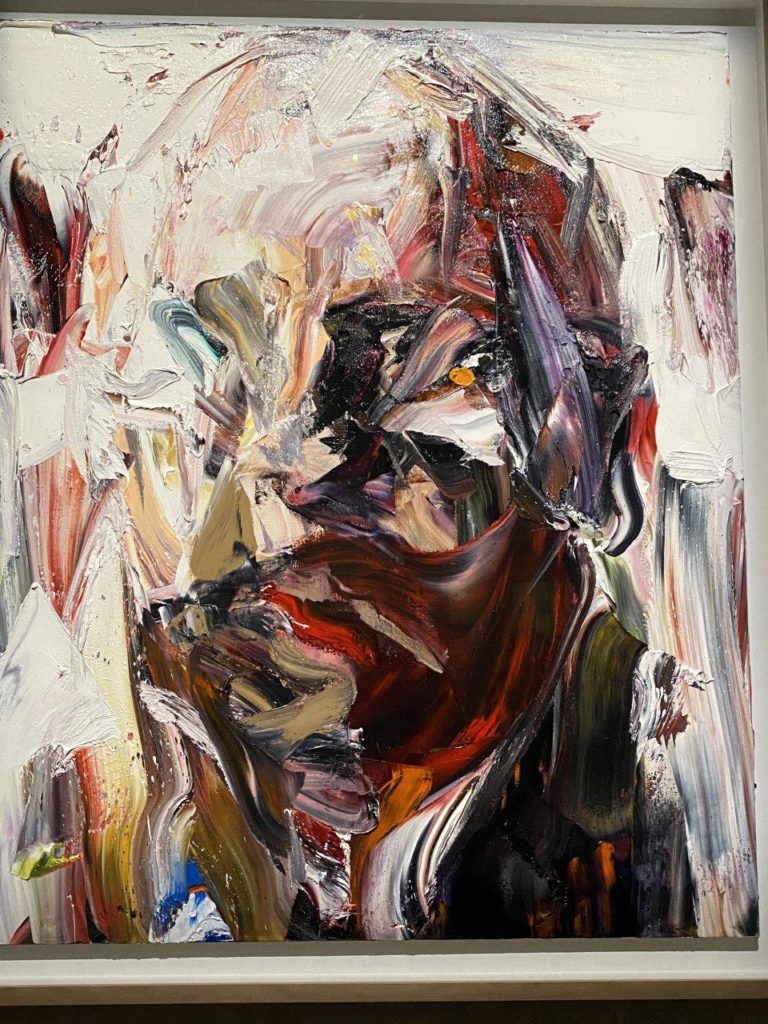
Again, it was tough luck – there weren’t any tickets available for purchase online, but same-day admittance was available at the museum; so off we went in search of golden tickets to the MOT (Museum of Contemporary Art Tokyo). By now we were savvy transportation experts (Ha!), and five subways stops and a brisk walk through a lovely neighborhood brought us to the museum.






We got to the MOT just as the ticket desk opened and immediately got into line behind 200 excited museum-goers (99.5% women all dressed to the nines, many in Dior). David wondered if there was even a chance we’d get in. I thought it possible, as I discretely watched a museum employee near the ticket booth clicking a hand counter every time someone new got into line.


One and a half hours later, we had our timed-entry tickets for the early afternoon. With two hours to kill, the contemporary museum’s other exhibits beckoned, with a little nosh in the cafeteria to sustain our fashion souls.

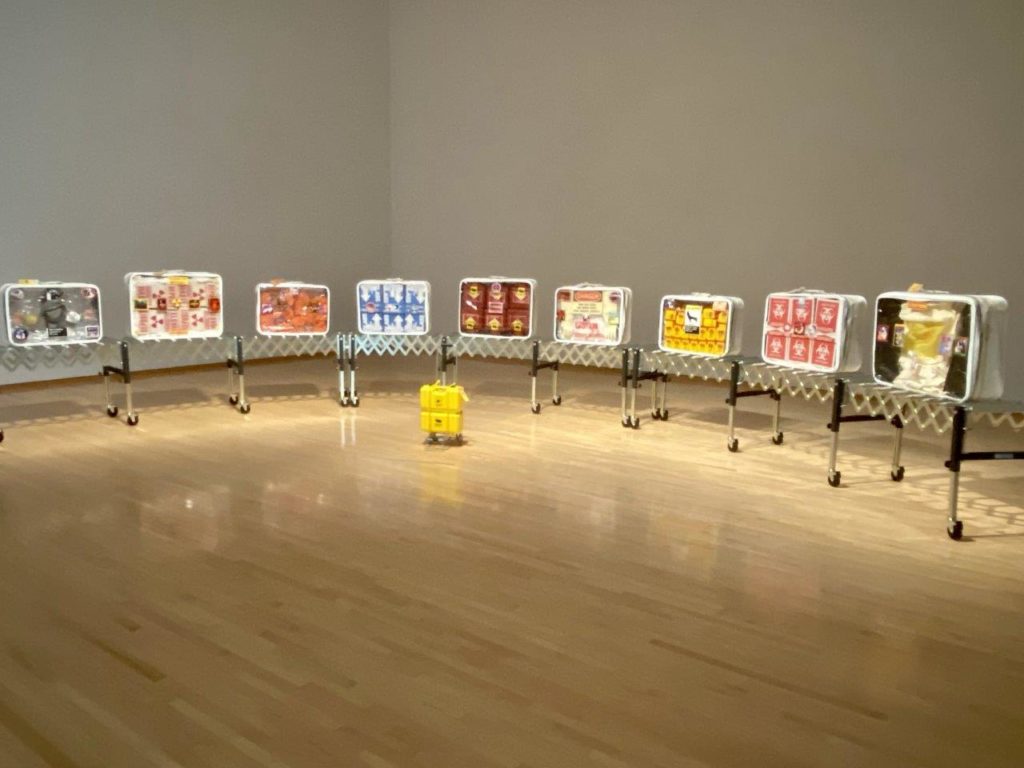
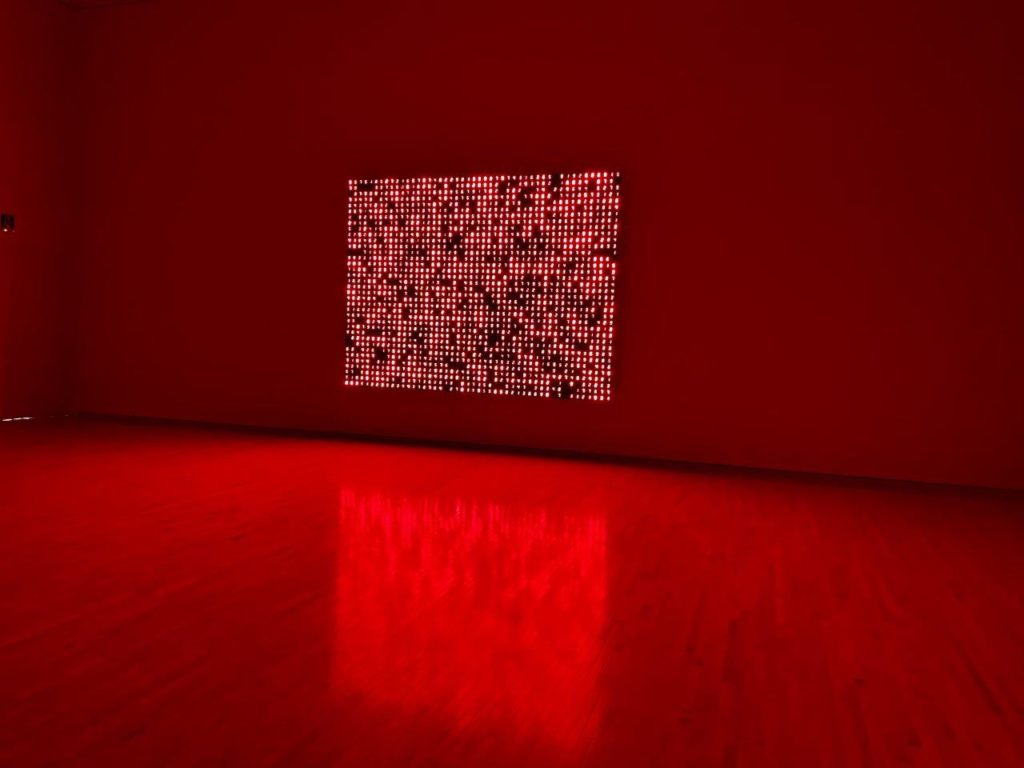
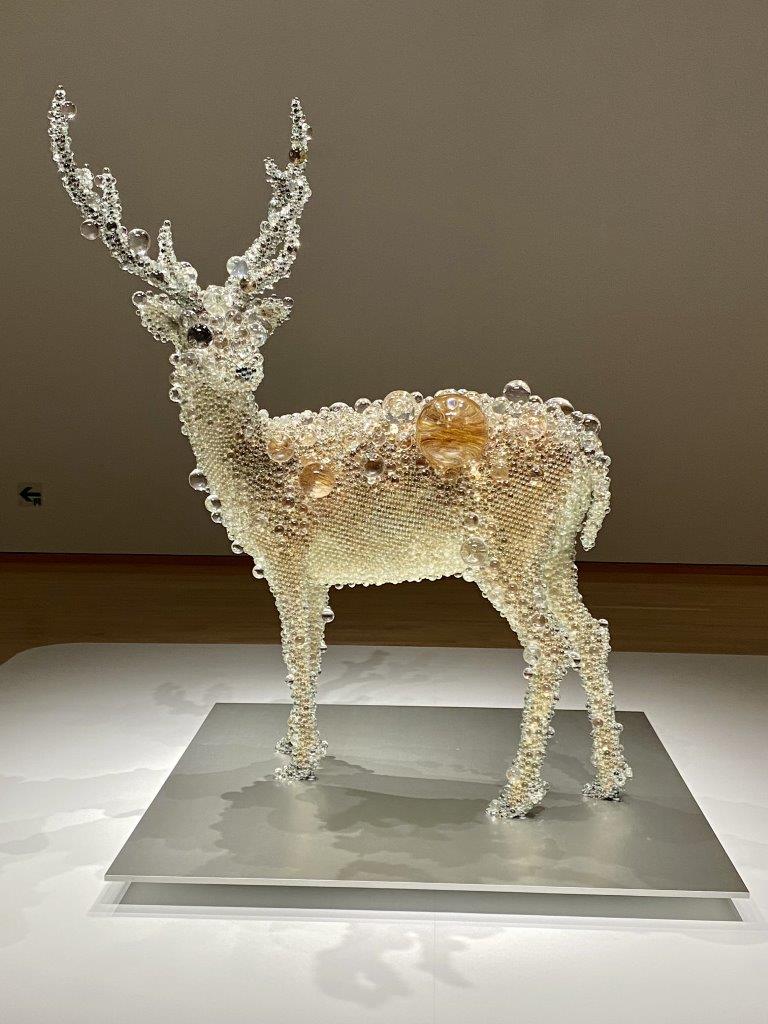
Over the past six years, the Dior spectacle has traveled the world, appearing in: Paris, London, Shanghai and Chengdu, China, Brooklyn and Doha, Qatar. Dior had a lot of respect and fascination for traditional Japanese culture and was fascinated with the country’s art; consequently, his designs were greatly influenced by the refined Japanese aesthetic sensibility. The Tokyo stop includes an exclusive additional “Japan Room” paying homage to this. This was my favorite room of all …



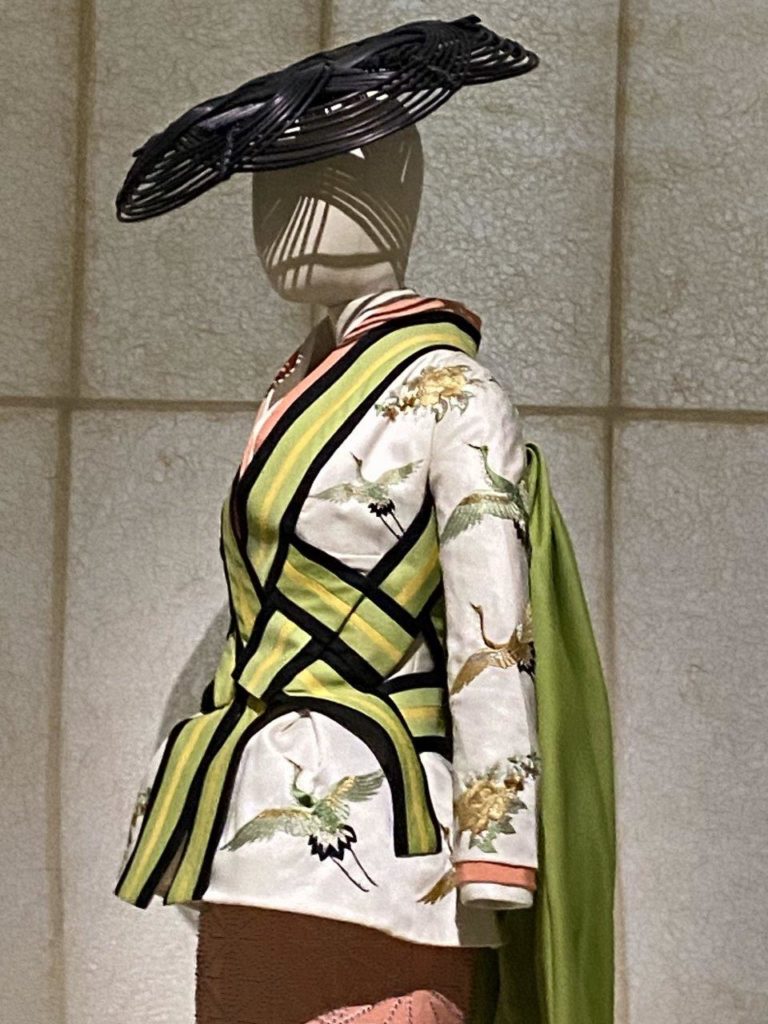


The exhibition spans 12 rooms featuring over 350 haute couture dresses, plus accessories, photos, videos, and documents from the Dior archives. Also highlighted were the work of the six designers who have led the House of Dior since his death in 1957, including: Yves Saint Laurent, Marc Bohan, Gianfranco Ferré, John Galliano, Raf Simons, and the current designer, Maria Grazia Chiuri.




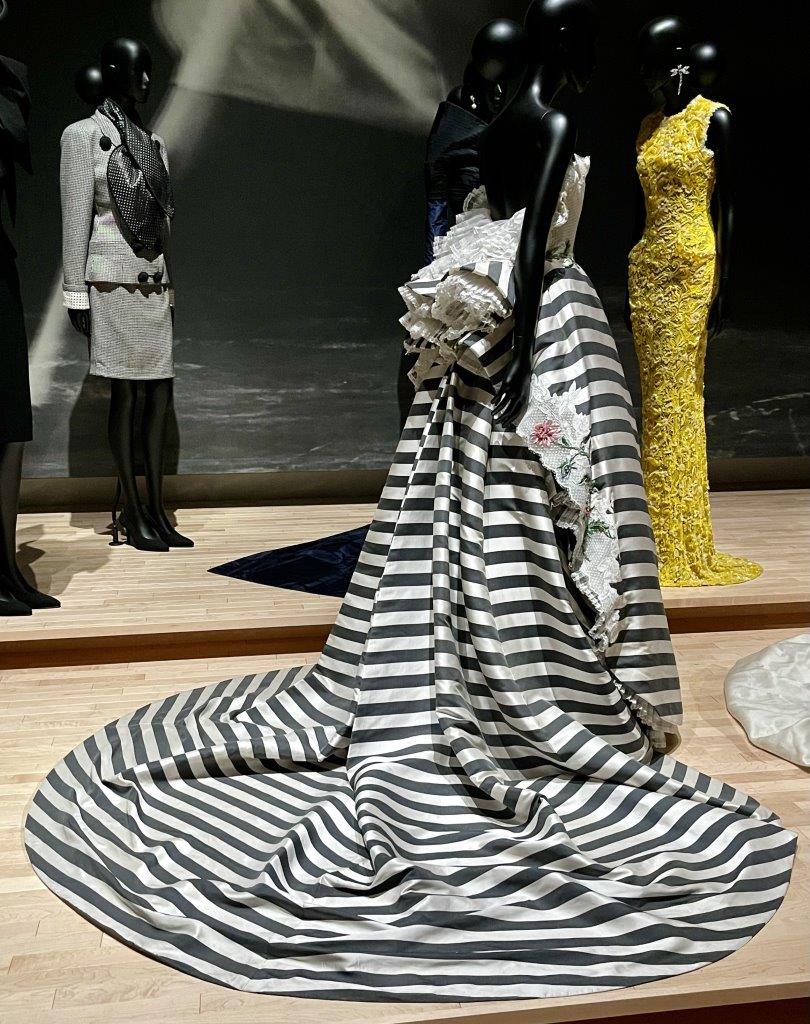


A who’s who of movie stars, famous muses and clients and their Dior dresses are shown; as was the strong bond between Dior and the Japanese Royal Family.

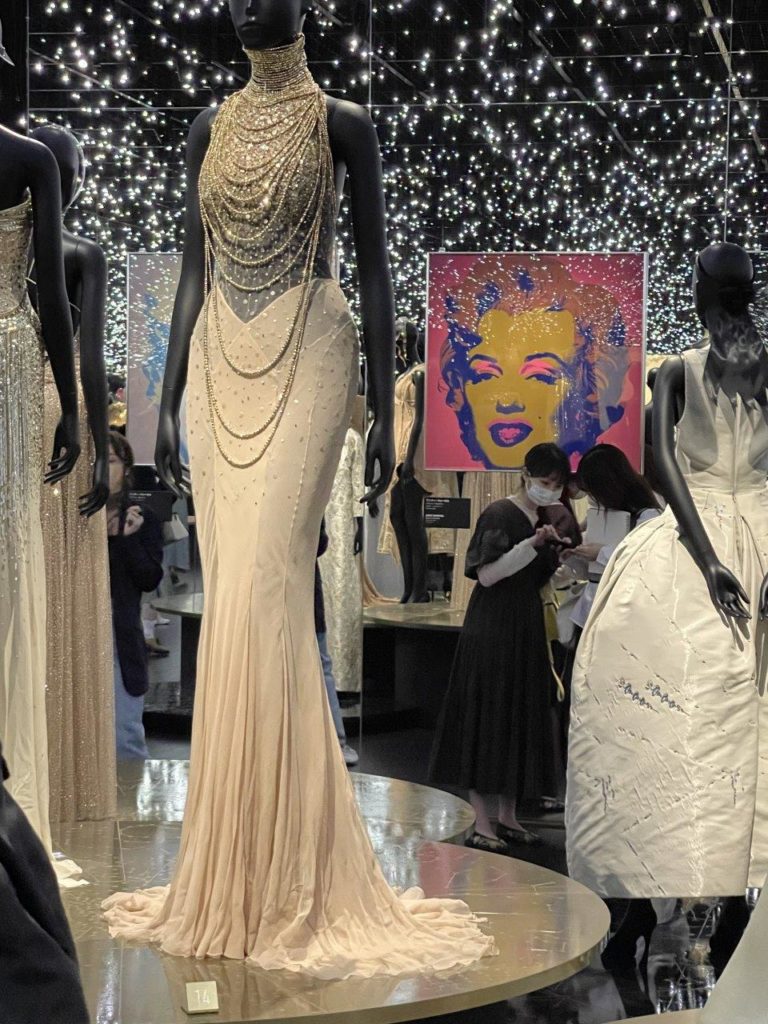
The first department store to carry Dior in Japan was Mitsukoshi, one of the oldest and most prestigious department stores in the country. In 1953, Mitsukoshi had its first Dior runway show. It became a popular destination for fashionable Japanese women who admired Dior’s elegant and sophisticated designs.
I’ll let David take over from here, since all I can say is that the clothes and accessories were beyond beautiful, they were magnificent …
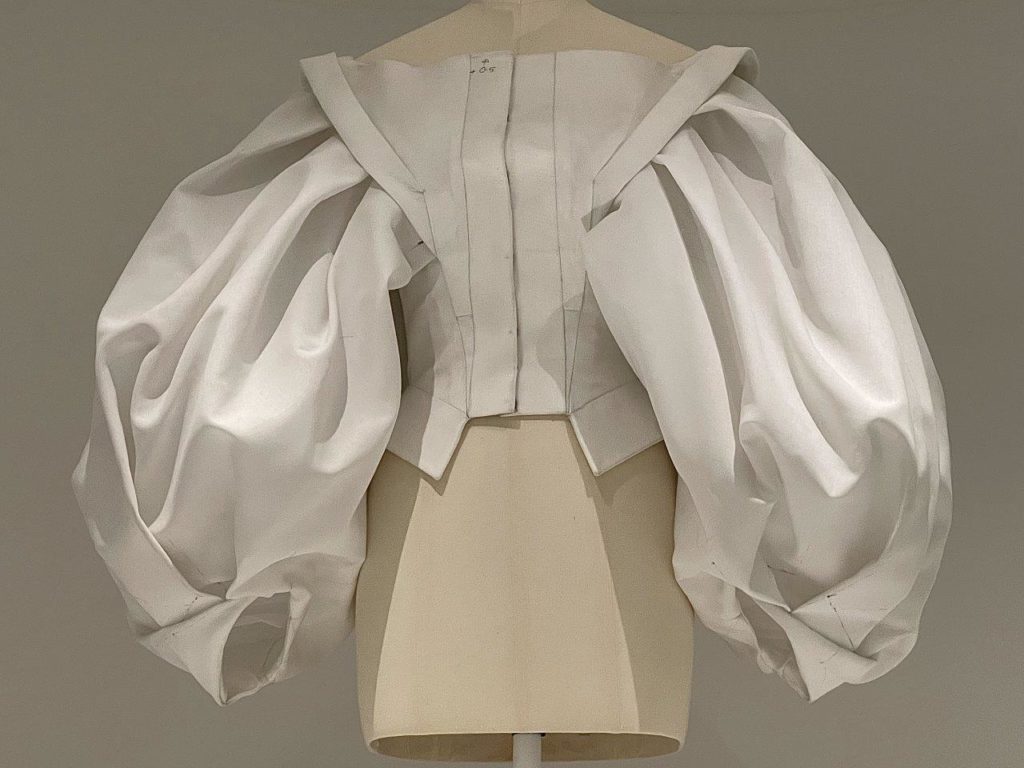




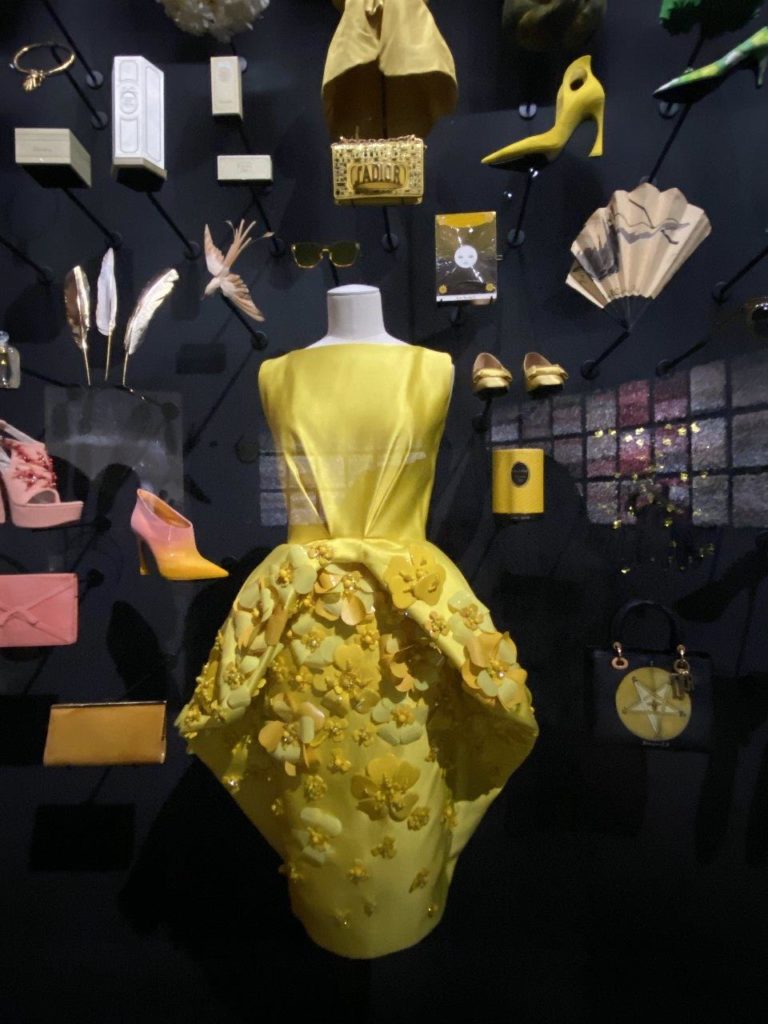




… and presented in the most exquisite and creative manner, with high reverence. From the moment we entered the exhibition, we knew we were going to be amazed and awestruck because the “Bar” suit, Dior’s famous “New Look” silhouette of 1947 opened the path forward into fashion nirvana. The jacket’s tight waist and peplum flare worn over a wide, full skirt was and remains an important landmark; the suit was instrumental in reviving the gloomy Paris’s post-war era after years of austerity.

Christian Dior incorporated many classic elements in designing: line and architecture; influence of history and art, color; floral gardens and landscapes were major sources of inspiration.
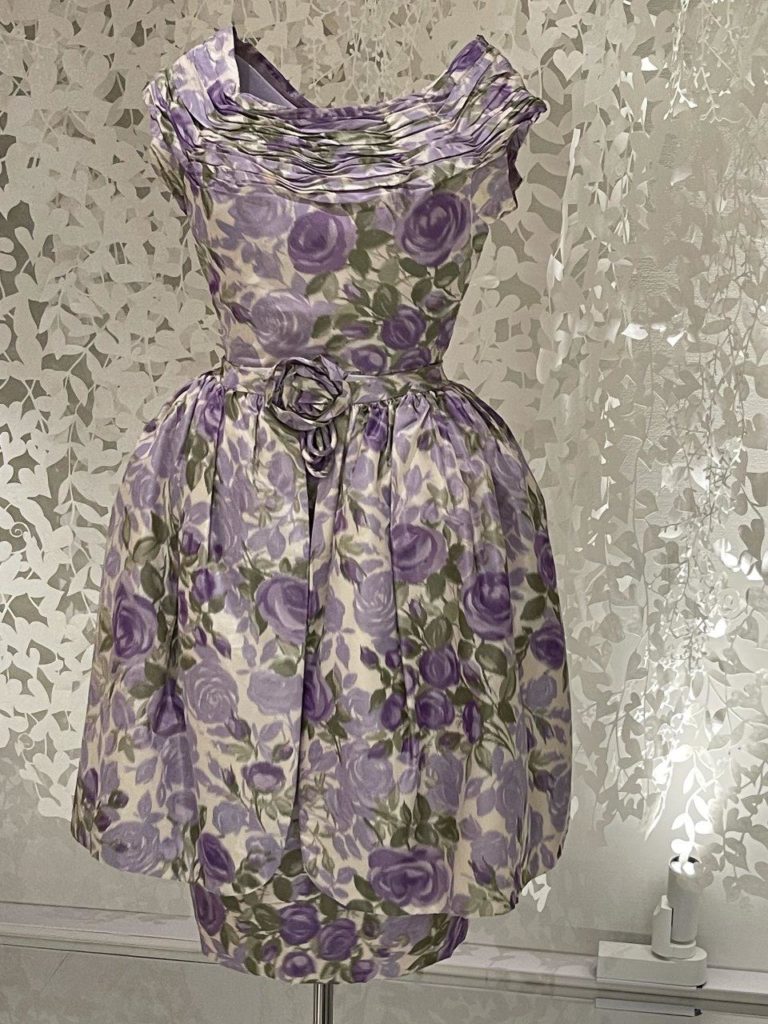


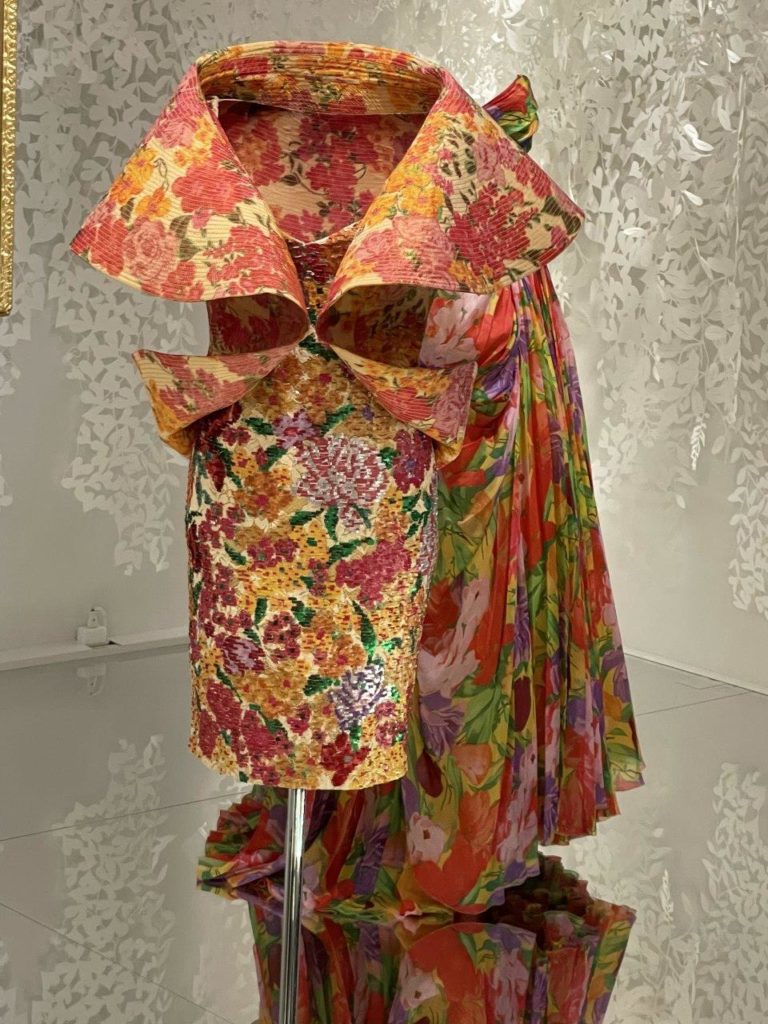



You don’t have to be fashion savvy in order to appreciate the extraordinary work on display. The craftsmanship and detail work was amazing; with luxurious fabrics and designs beyond compare. It was like walking through a fashionista’s dreamscape, each room more beautiful.






Just as you finished admiring each thematic room and thinking you’re nearing the end, you turn a corner and another fantasy opens up before you to take your breath away.

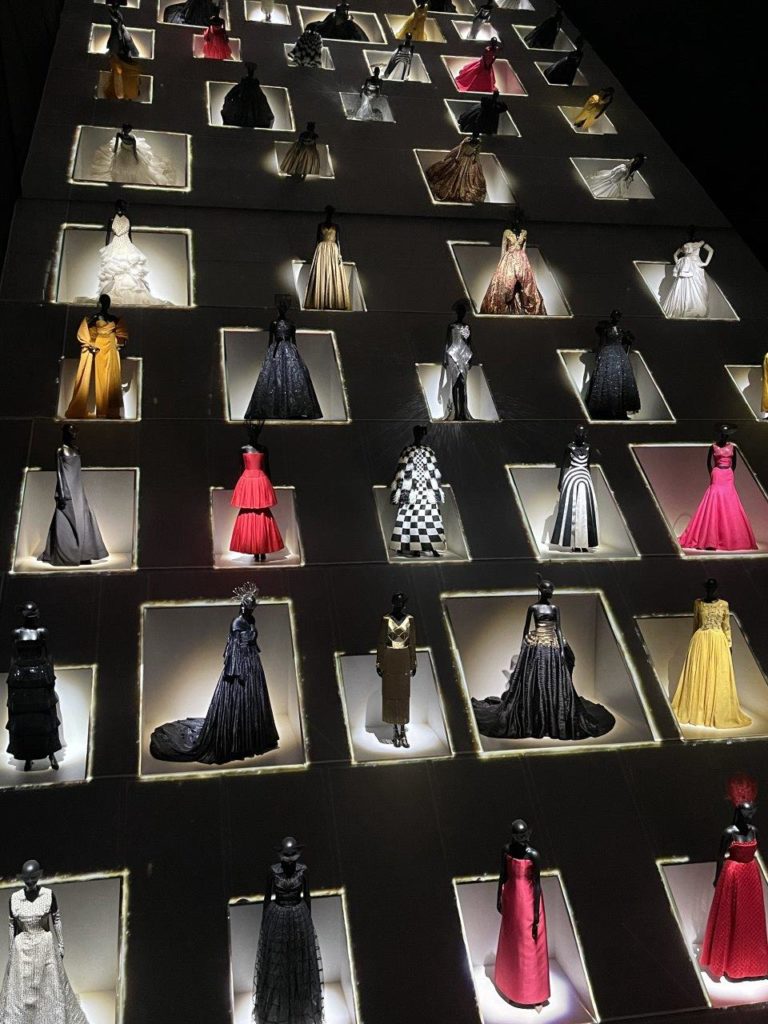



I can throw every superlative word out there and still can’t convey the overall effect this incredible fashion exhibit provides the viewer. I’d mouthed, “WOW!” so many times, my cheeks began to hurt.

Today’s all day museum-going left us exhausted and hungry. It led us to an Indian/Malaysian restaurant tucked away in the subterranean level of the Shiodome business complex below our hotel. A different change-up of spices awaited, but still delivered the umami flavors we’ve been accustomed to. David devoured his Chicken Tikka, and my curry was mild, but very flavorful. We ate lots of garlic naan; warding off any Japanese mythical creatures, such as Nure-onna, a snake-like woman that feasts on human blood.
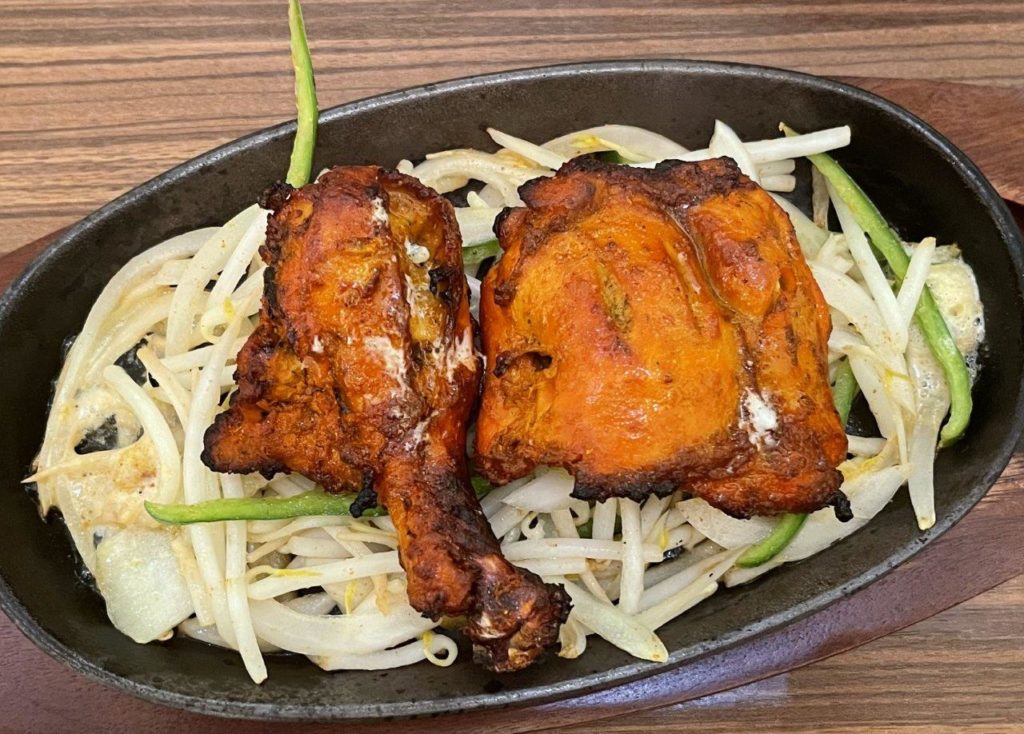


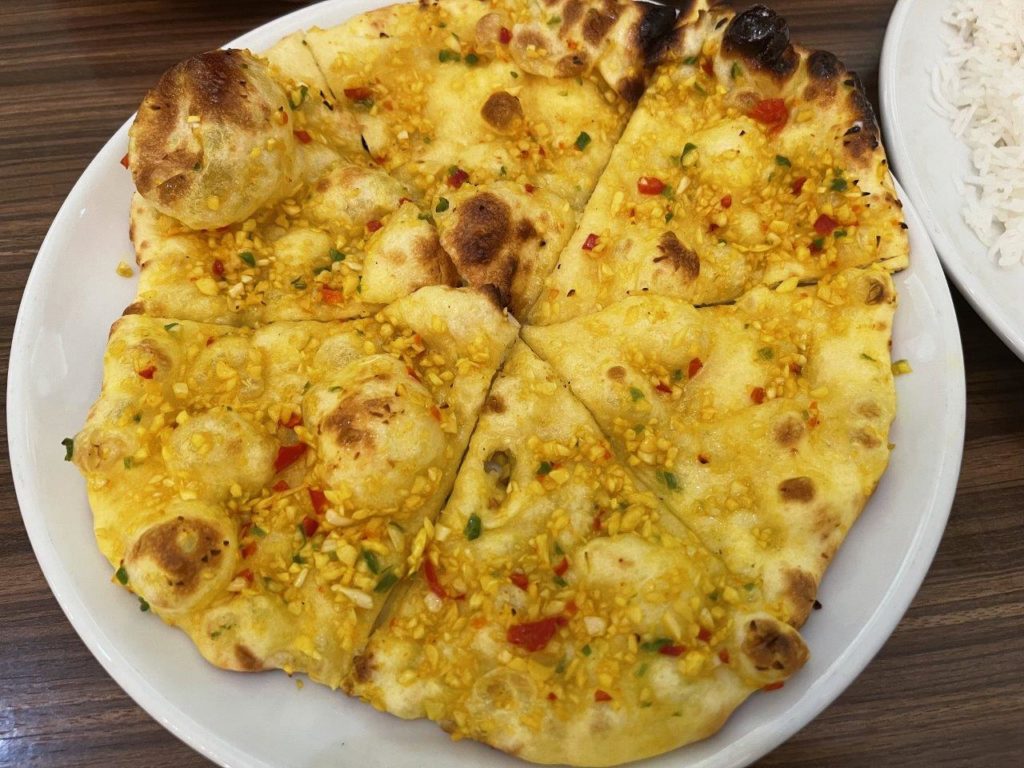
Kit Kats
Kit Kat has cult-like status in Japan since being introduced to the country in 1973. The Japanese are downright obsessive with this crispy little chocolate wafer bar. Did you know that in Japan, there have been more than 300 limited-edition, seasonal and regional flavors introduced since 2000? Krazy, huh?!
Many flavors are exclusive to the country and not produced elsewhere, making them high in demand and collectibles. The scarcity and rarity make them valuable commodities and popular gifts. Who knew?! Sweet David did.
The Japanese pronunciation helps explain their popularity – Kit Kats are pronounced “Kitto Katto” in Japanese, which sounds familiar to the phrase “Kitto Katsu,” meaning “good luck” or “definitely win.”
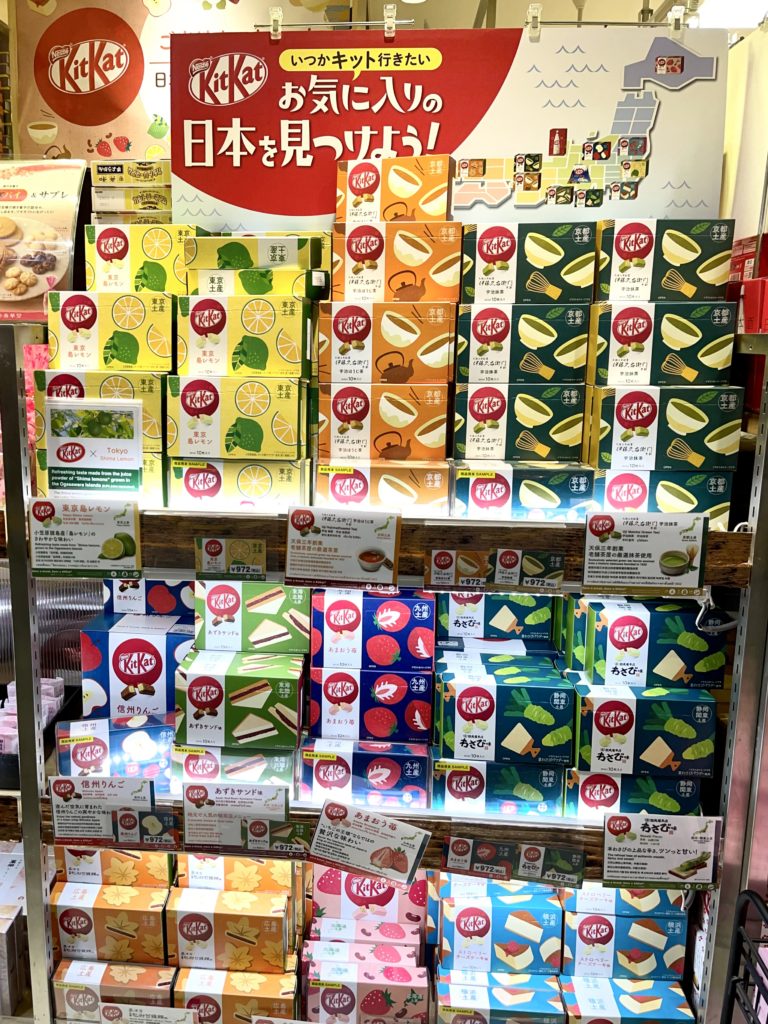
Because of this, the country considers Kit Kats to be a good luck charm, and a great gift, especially for students studying for exams.
Here are some of the popular and unique flavors of Kit Kat bars created over the years:
Matcha (Green Tea), Banana, Hojicha (Roasted Tea), Strawberry Cheesecake, Caramel, Wasabi, Soy Sauce, Azuki Bean, Purple Sweet Potato, Rum Raisin, Lemon, Orange, 72% Dark Chocolate (my favorite), Coffee and of course, during Cherry Blossom Season, a Sakura flavor.
And then there’s Sake flavor that we saw being sold in special gift packaging, combining sake powder with white chocolate. David drew the line on that one, domo arigato; preferring drinking it vs. eating it.
More sweets for my sweet ~ David spent every last, leftover Yen at the airport on five different flavors of Kit Kats, and came home with a bag full of luck!

“Have a break … have a Kit Kat.”
Tokyo National Museum
It’s our final day in Tokyo. Let’s finish with a flare at the Tokyo National Museum, being one of the most prestigious and largest museums in Japan, established in 1872. It houses a vast collection of art and antiquities, including Japanese and East Asian art. We’ll experience one last taste and savor classical Japanese culture to take back home.
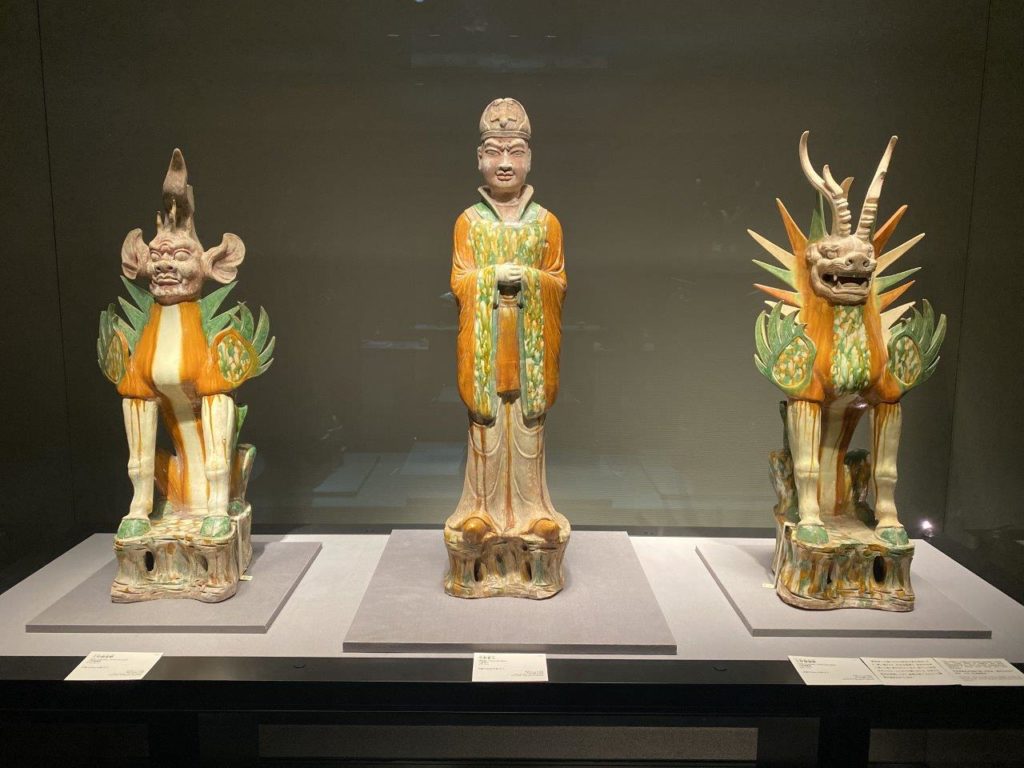
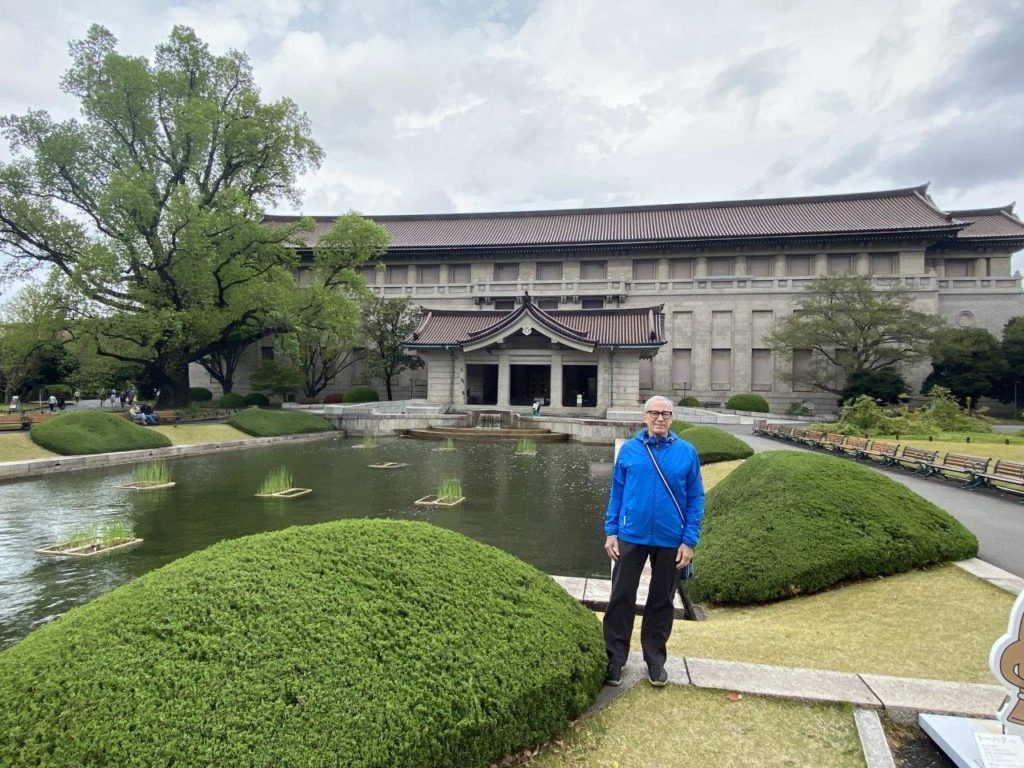
The museum has several galleries, each dedicated to a specific period or genre of Japanese art. On display, a wide range of exhibits, including: paintings, sculptures, calligraphy, ceramics, textiles, and archaeological artifacts.
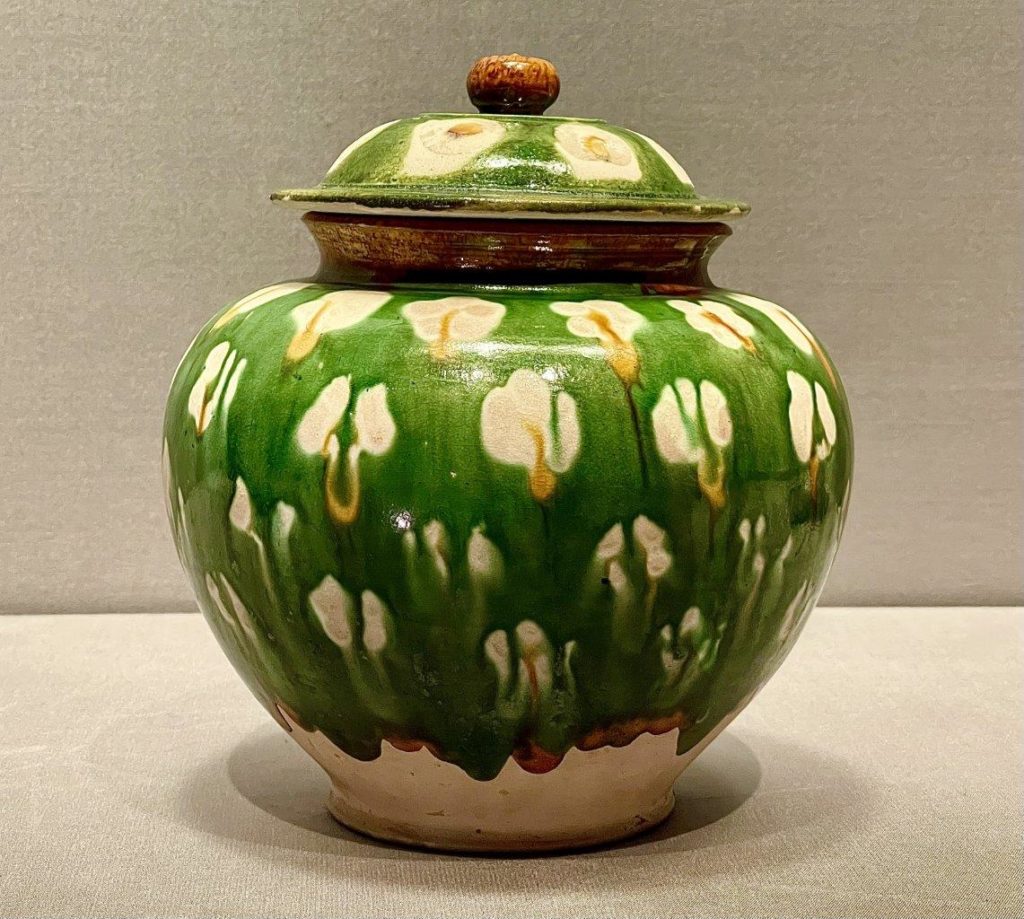




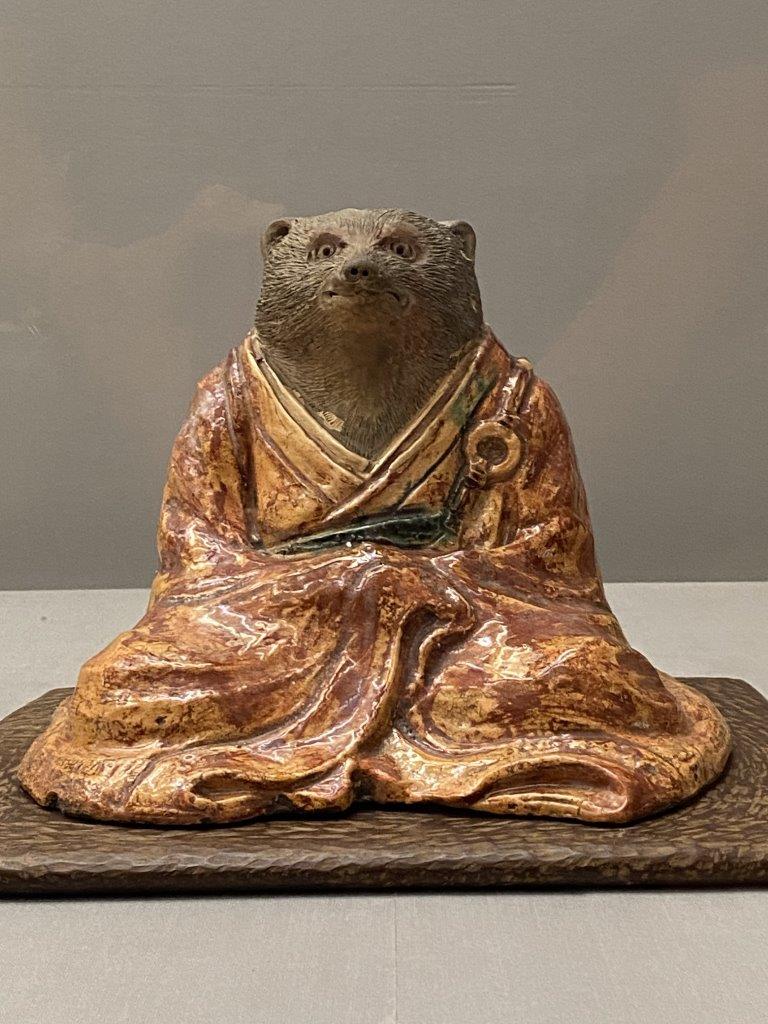

One of my favorite areas of the museum was the incredible Netsuke Room. Netsuke are used in classic Japanese dress as a toggle close to fasten a small pouch or container to a kimono sash.
Netsuke were used from the 17th – 19th centuries. They were an important part of Japanese fashion during this time. Netsuke are like miniature sculptures; typically made of ivory or wood.
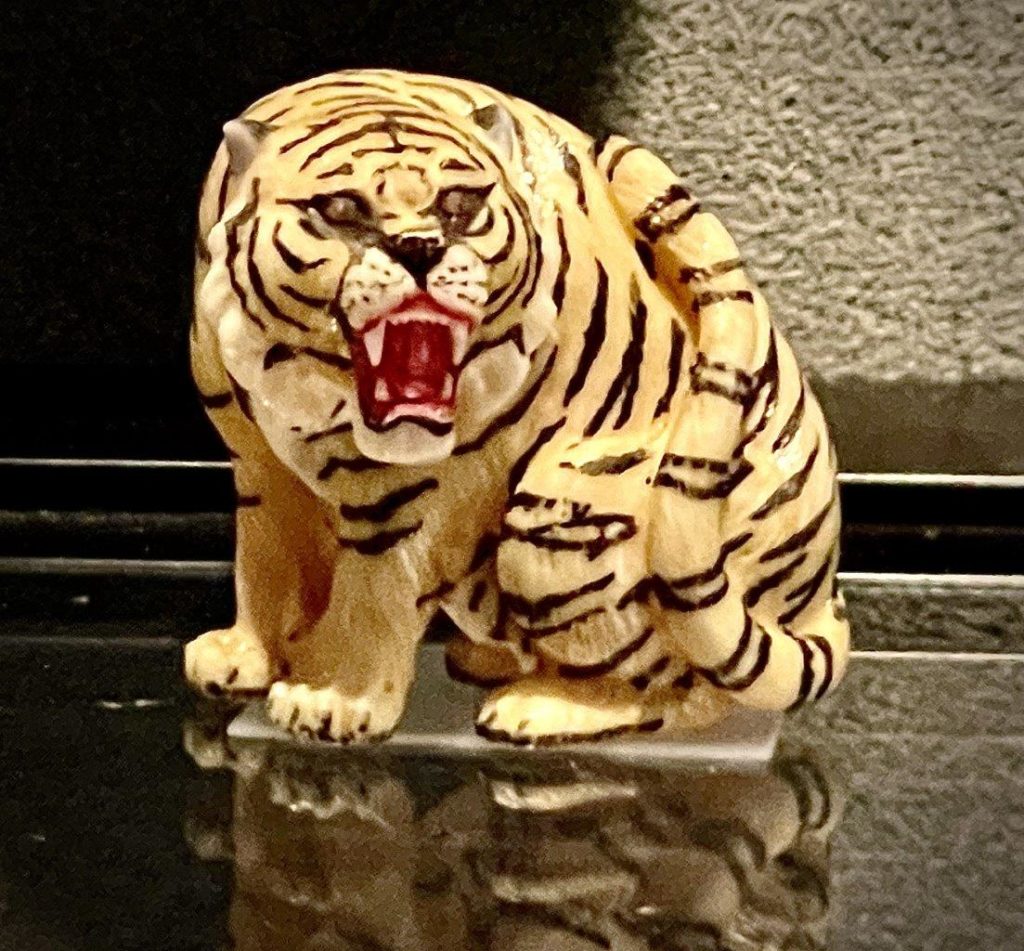

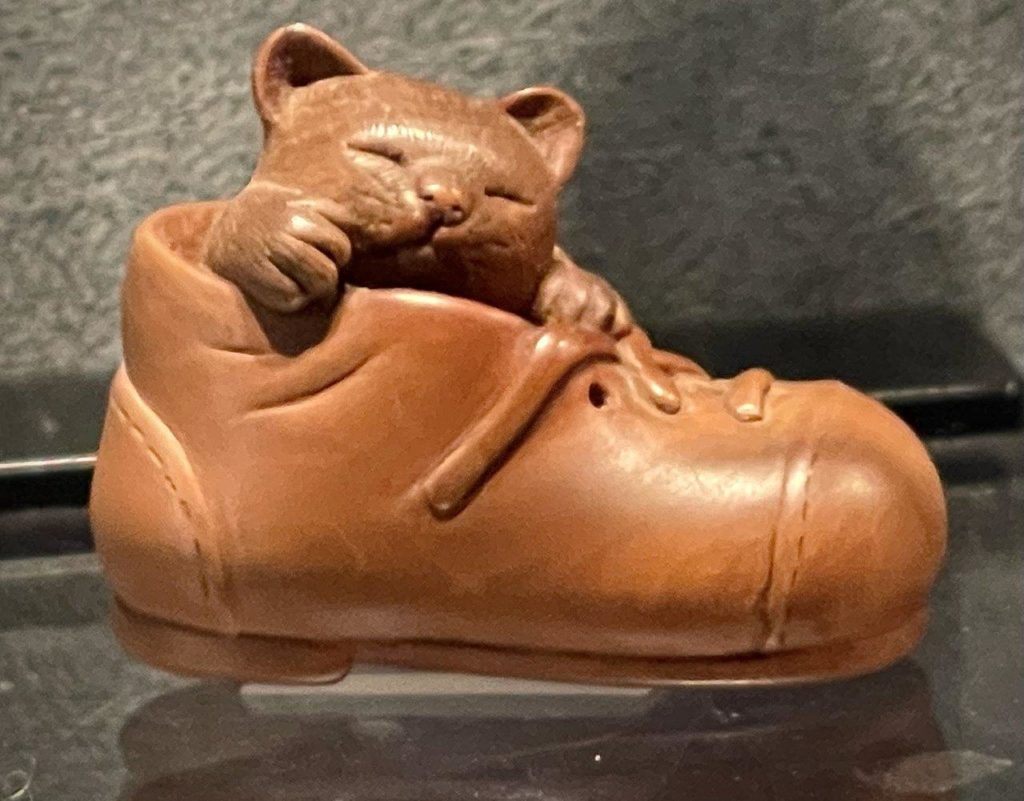
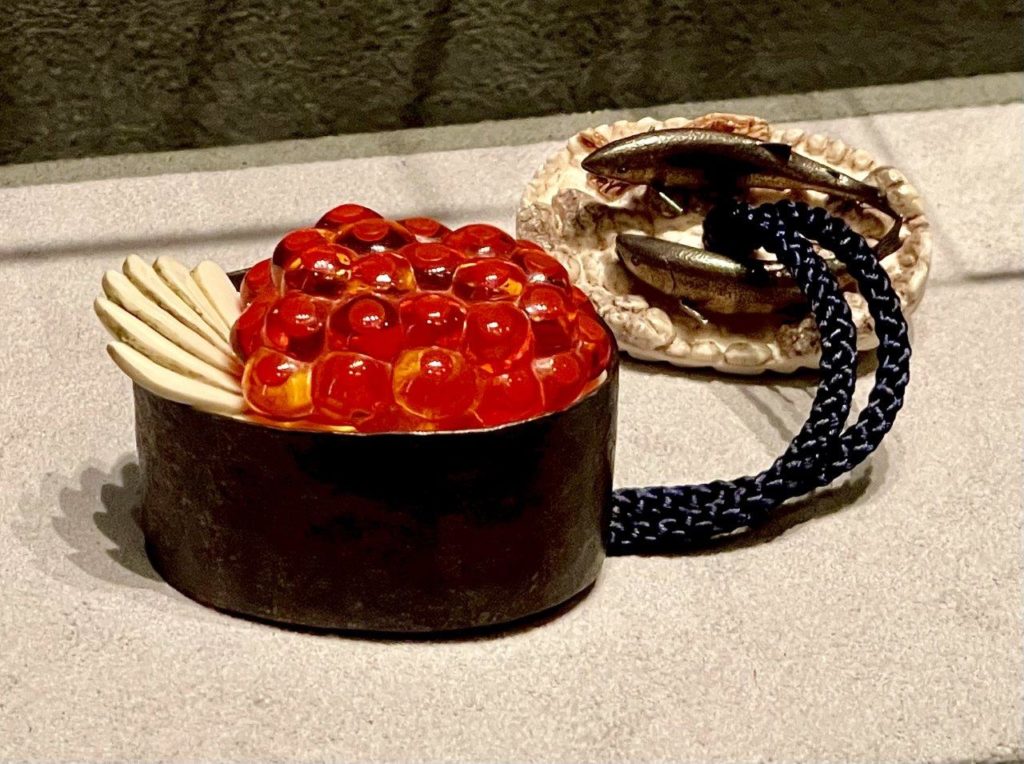
They’re often intricately carved with various designs and motifs: animals, people, mythical creatures, and scenes from Japanese folklore. Over time, they evolved into ornate objets d’art. Today, Netsuke continue being produced and command high prices.
The museum, too, houses a significant collection of priceless kimonos, from various historical periods. These gorgeous garments showcase great craftsmanship and artistic traditions associated with this iconic Japanese garment.





Another favorite were the Shoji screens, a long-established Japanese architectural element that consists of sliding panels made of translucent paper or fabric mounted on a wooden frame. Shoji screens have been used in Japan for centuries and are known for their delicate beauty and practical functionality.

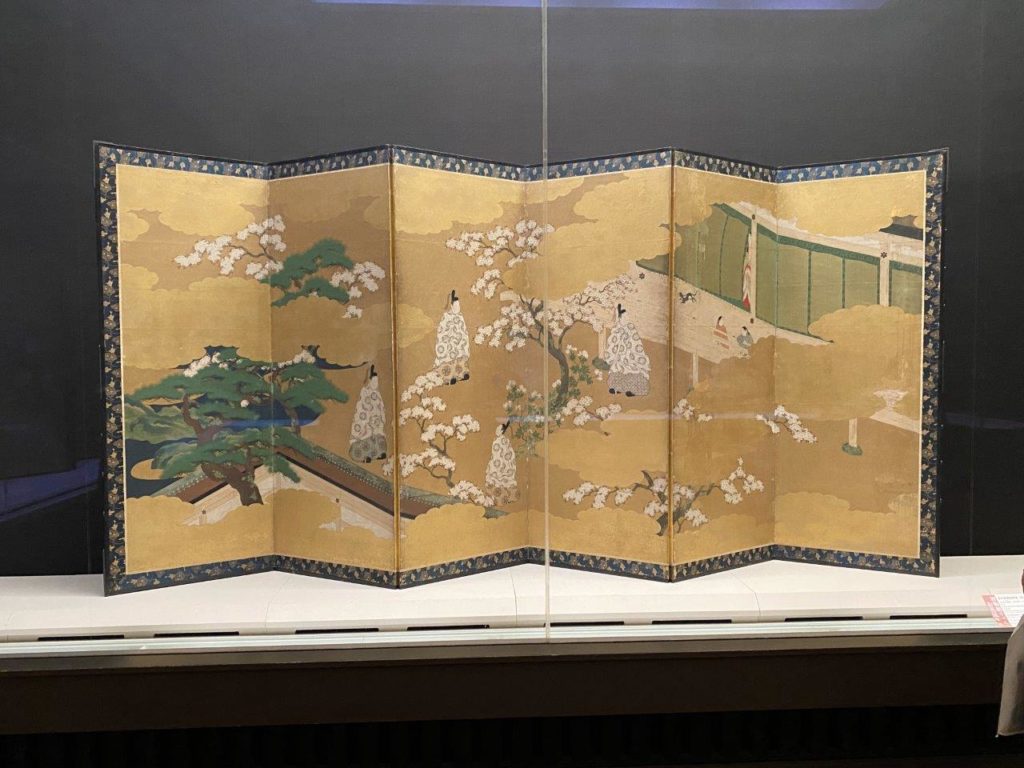
Afternoon High Tea
Since our first trip abroad to Hong Kong, if a city is blessed with a luxury Peninsula Hotel, our very own tradition dictates that we indulge in an Afternoon High Tea … this most sophisticated British custom, most civilized. With its substantial tiers filled with sweet and savory foods, the service becomes our early de facto dinner.
Tokyo’s Peninsula Hotel’s tea time extravagance continued the elegant ritual we’ve so enjoyed all over the world. The afternoon tea is served in the hotel’s rich, minimalist wood-inspired designed lobby, with live music emanating from above in a hidden mezzanine.


The menu’s Sakura motif included a selection of Cherry Blossom inspired treats. The 3-tiered silver stand was filled with tea sandwiches, freshly baked scones with Devonshire clotted cream and homemade jam; plus an assortment of pastries and cakes. It’s all gently washed down with tea chosen from a flavorful listing that includes both classic blends and exclusive Peninsula tea blends.

Always a unique and unforgettable experience; this version combines the flavors of Japan with the beauty of cherry blossoms. As expected, the Japanese presentation was beautiful and flawless; combined with outstanding service, it all added up to a delightful Afternoon High Tea. It closes out our Japanese adventure on a happy high note.

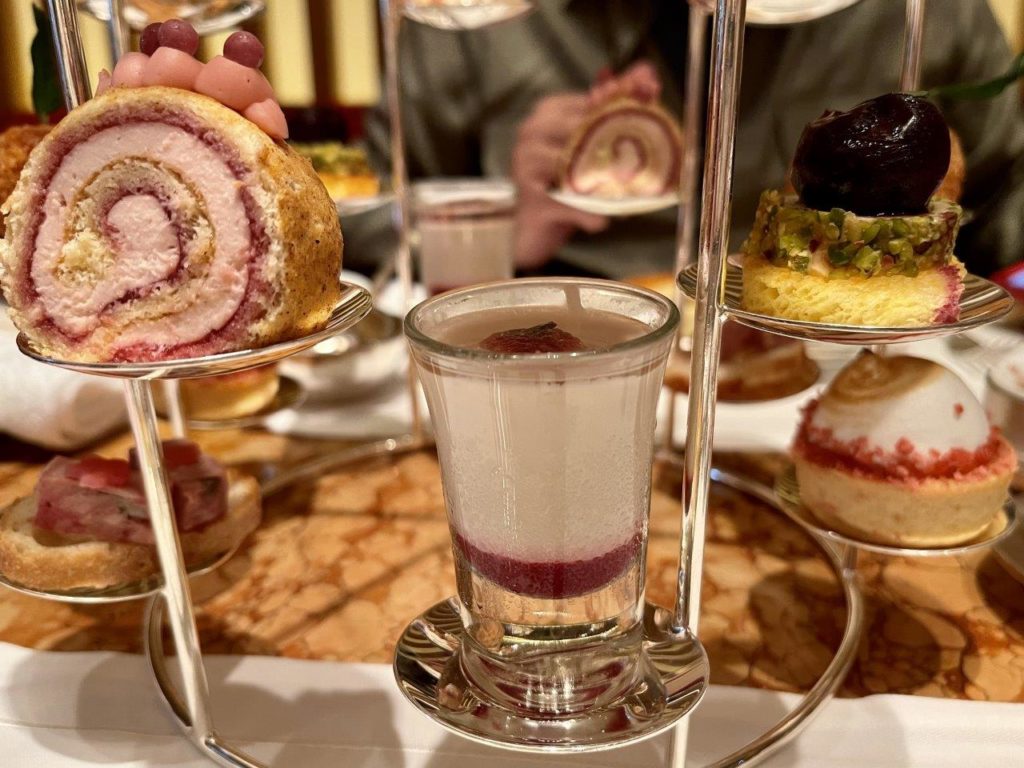
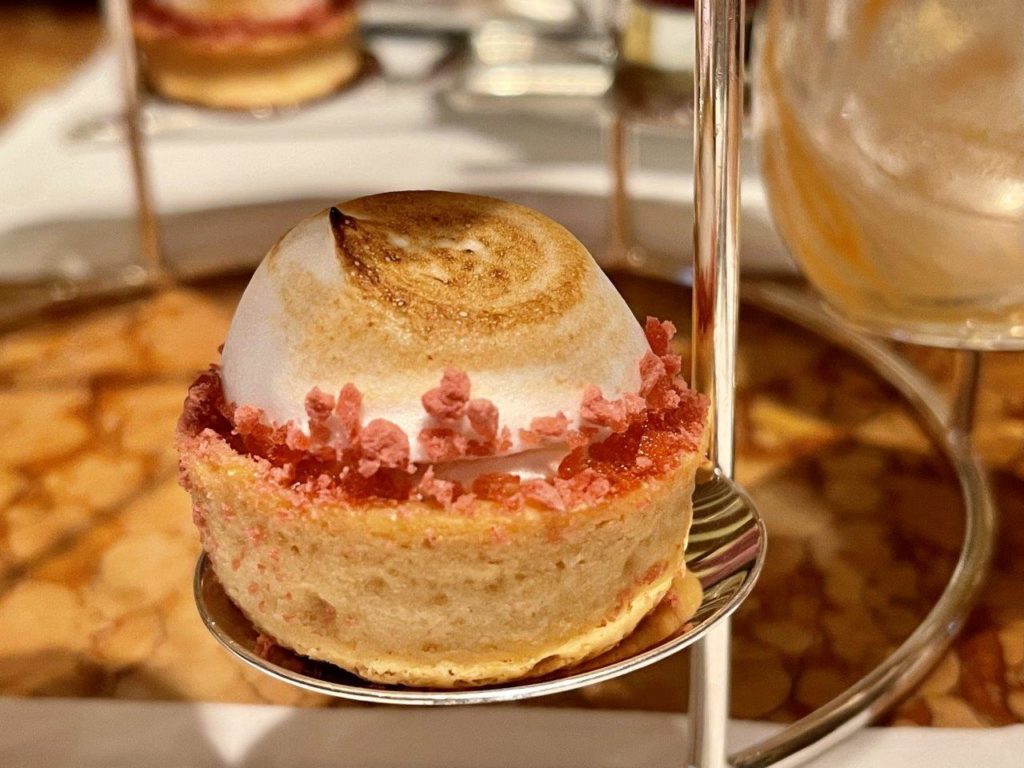
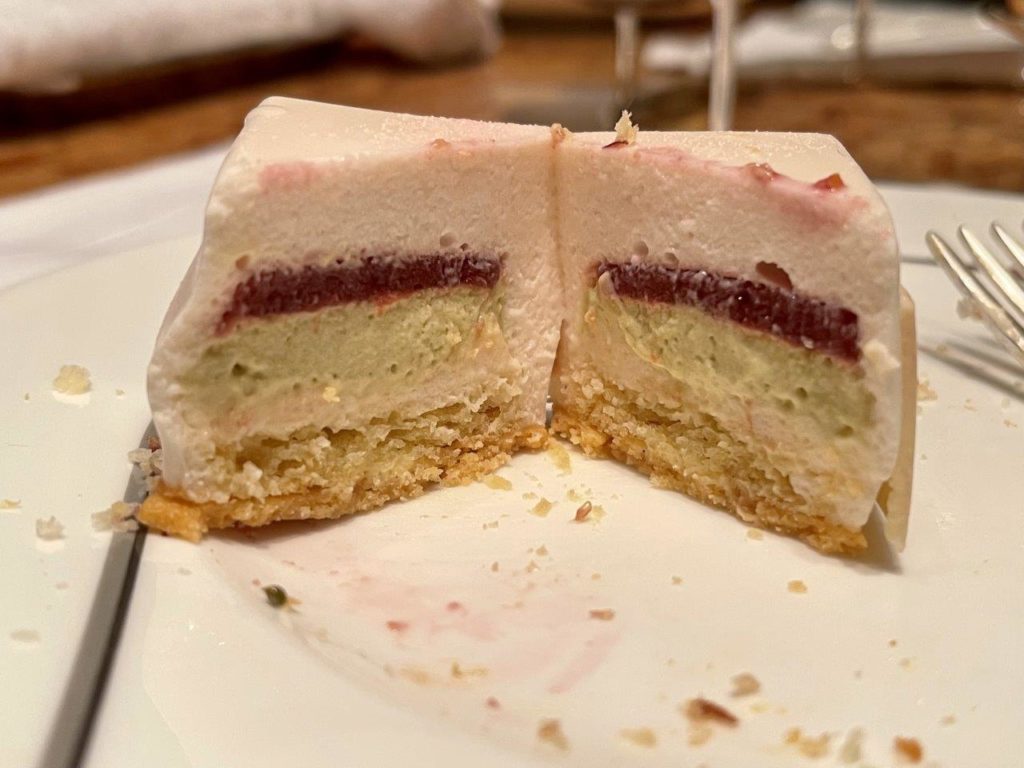
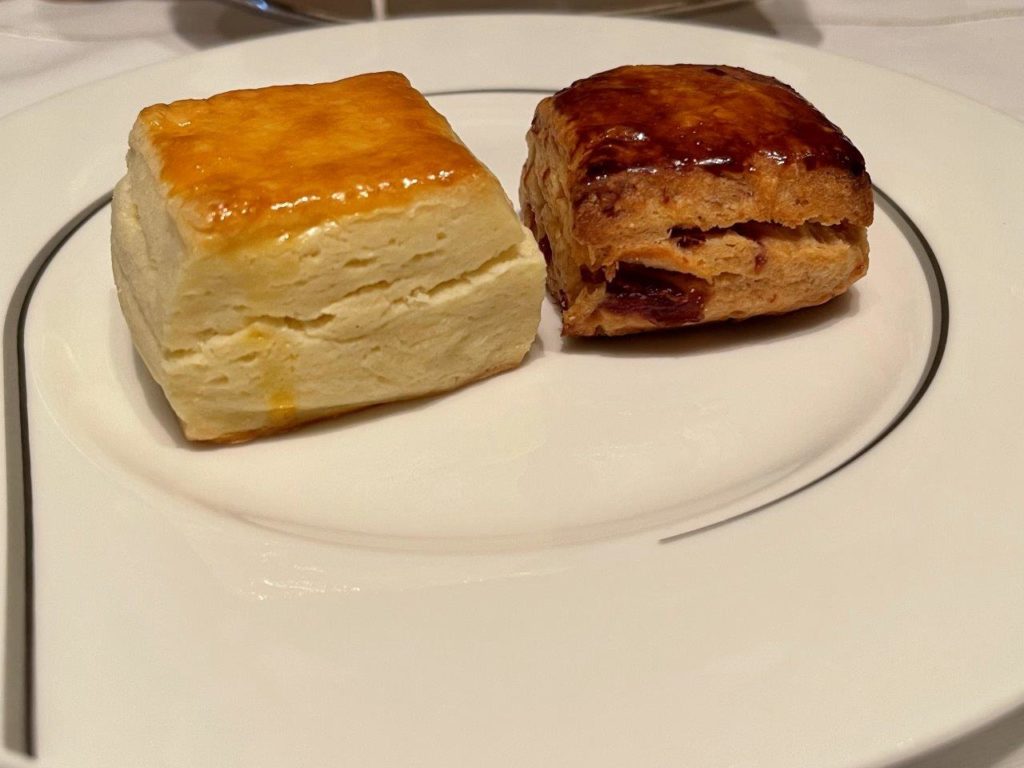
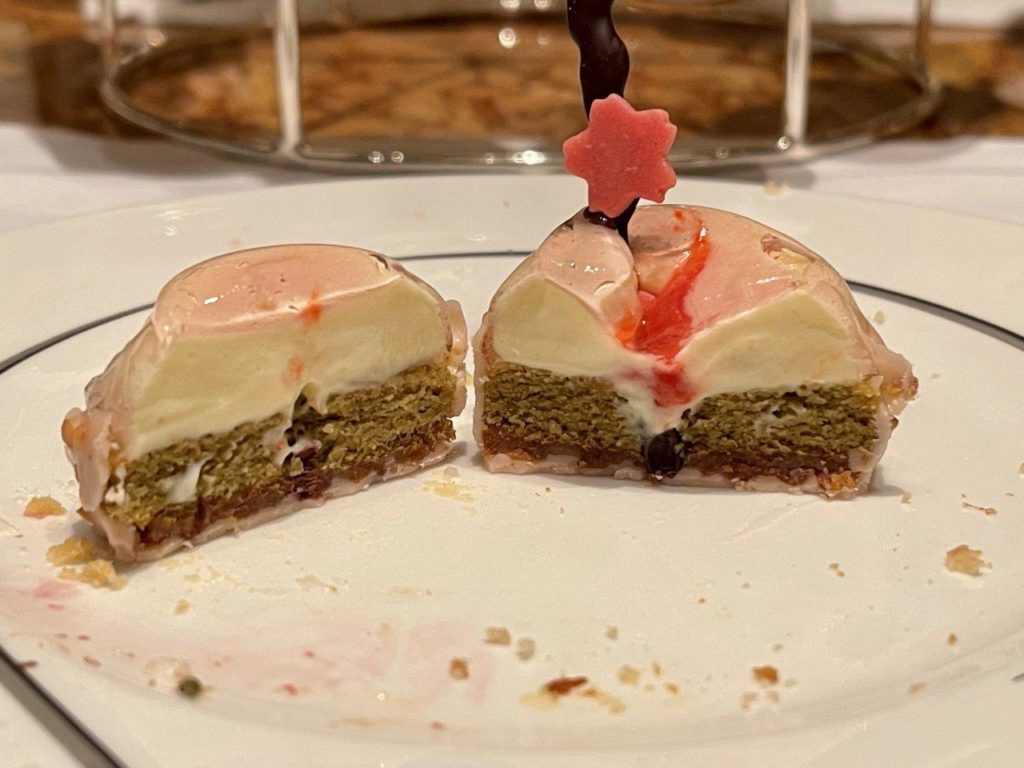
*****
As our incredible Japanese adventure ends, we’re overwhelmed with a deep sense of gratitude. Gratitude for the opportunity to explore this captivating country, immersing ourselves in its rich culture, and creating lifelong memories.
Grateful for the breathtaking landscapes that unfolded before our eyes, from the serene cherry blossom gardens to the majestic snow-capped mountains. Each scene seemed like a work of art, leaving us in awe of nature’s beauty.

Our heartfelt appreciation extends to the warm and welcoming people we encountered along the way. Kindness and generosity touched our souls, making us feel like a cherished guest in their homeland. Their genuine smiles and gestures of hospitality left an indelible mark in our hearts.
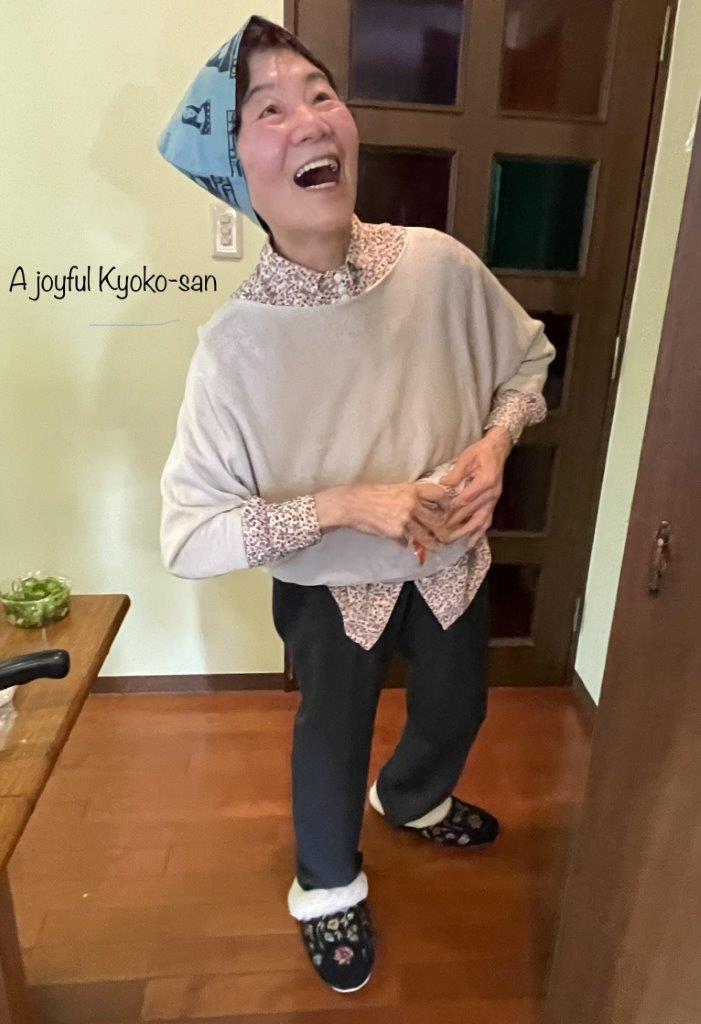
Thankful for the flavors that danced upon our palates, from delicate sushi rolls to steaming bowls of ramen. The culinary delights of Japan were an invitation to savor and celebrate their unique and tempting traditions.

Moreover, I am grateful for the opportunity to experienced firsthand some wonderful Japanese customs and traditions. From participating in traditional tea ceremonies to donning a Japanese yukata, we both embraced the beauty of a culture steeped in grace, elegance, and reverence for the past.
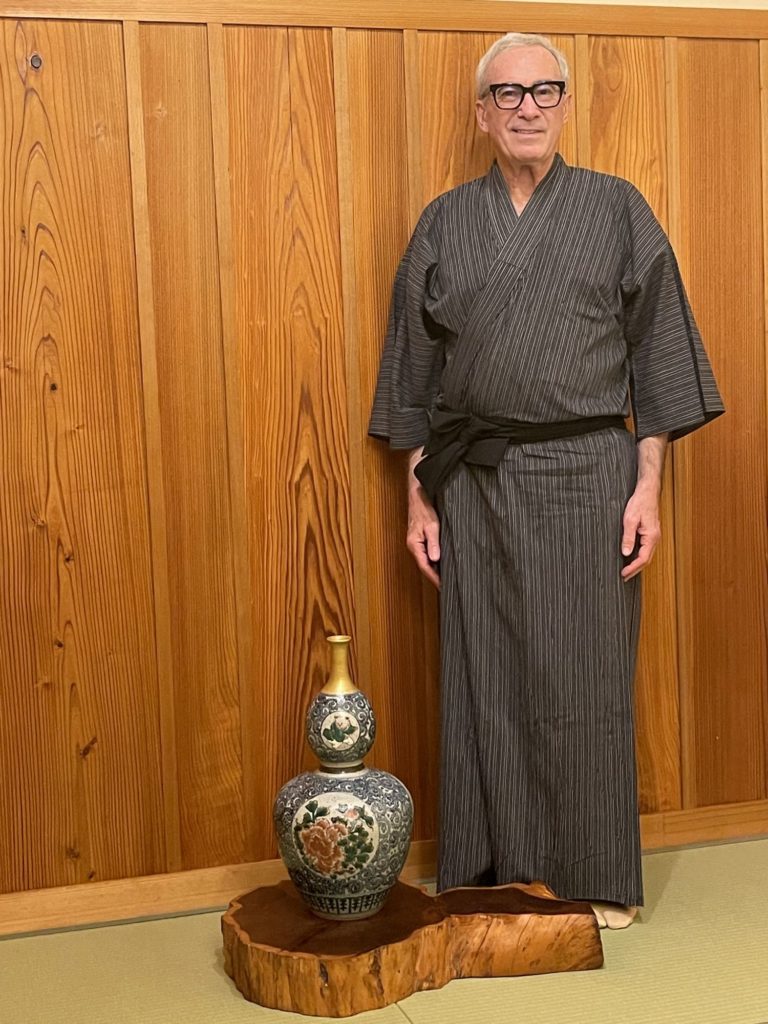
This journey has left an indelible and unforgettable impact on my life, as I’m sure it has with David. It has widened our horizons, shattered preconceived notions, and ignited a profound curiosity to continue to explore our world beyond our own comfort zone.
Finally, my deepest thanks to you, dear friends, for joining us on this narrative. Your presence in this storytelling adventure has added depth and meaning to our journey. It’s my hope that my words have transported you to the magical corners of Japan, evoking the same sense of wonder and appreciation that we experienced firsthand.
With a heart overflowing with gratitude, we bid farewell to Japan, carrying its beauty, lessons, and cherished memories within us. May the spirit of exploration and gratitude continue to guide us on our future adventures, wherever they may take us.
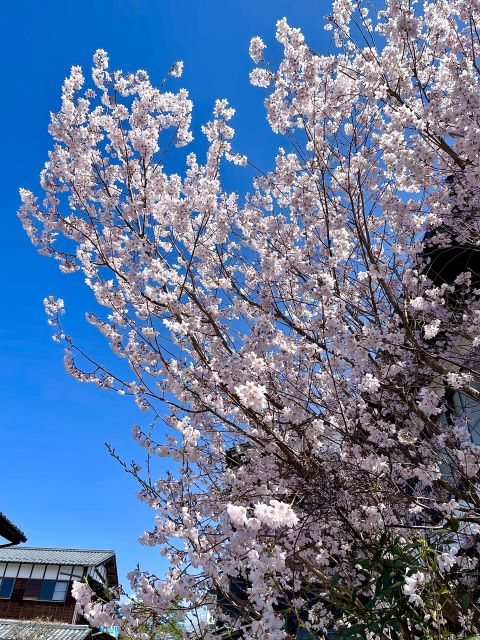
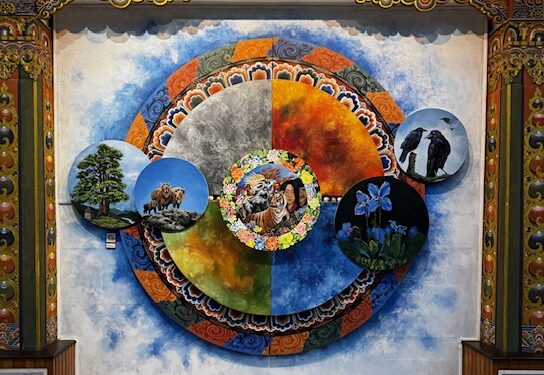
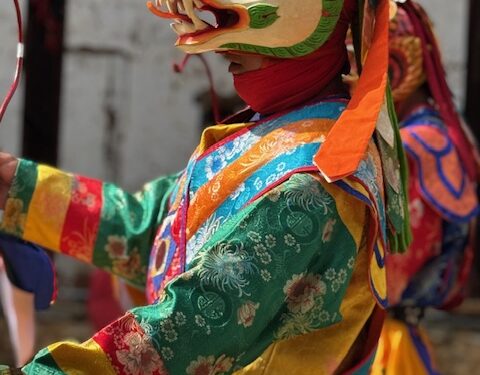
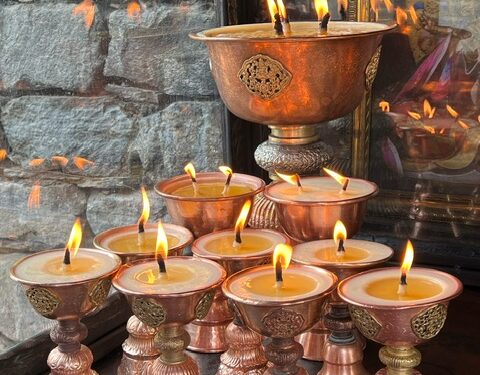
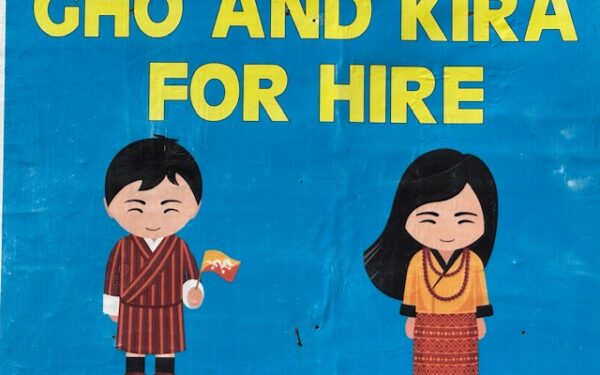


Good Morning Samurai Sergio-San & Feudal Lord David-San. Your adventures are so vivid, entertaining & educational. Thank you for sharing your visit Japan!!
As usual, a fabulous trip with you, through word and pictures. Thanks for letting us join. Highlights for me were the food, the Dior fashion (that Cherry Blossom bag!!!!!!). The scenery, fabrics – thrilling!
David in a yukata! Dior extravaganza, Mt Fuji, cutue/patootie cars and swiftly moving rails! I didnt know about the KitKat phenomena-/this Japan saga was truly incredible! Where did you find your wonderful local guides? Congratulations on the creme a la creme travel.
What a lovely tribute to Japan, its culture and its people these eight segments have been. Through rich narrative and color saturated photos, you invited us readers to experience the magic of Japan’s Sakura, Temples, Shrines, Art, Cooking (adorable Kyoko), Fashion, Scenery, Architecture, Museums and yes, even the craze over Kit Kats. Thank you once again for providing such a fascinating journey, Sergio and David.
I love the completeness of your blogs! I feel like I’ve been there too…thanks 👍
Oh my word! You two really know how to find the beauty!! Thank you beyond words!!!
just WOW- i could Dior-all day- you both have made this journey so alive with your narrative and your pictorial show-
its been incredibly enjoyable- thank you-
e
This trip has been a feast for the senses. At times I felt like I could smell and touch what you were describing. The Dior show was an absolute piece-de-resistance. The culmination of all the sensory marvels, manmade as well as organic. Thanks for taking us along.
What a lovely blog! Thank you for sharing your adventures and I look forward to reading more. It was a pleasure to meet both of you today and have good laughs at lunch.